Statue of Liberty and Ellis Island
Statue of liberty and ellis island tour, the global award-winning tour of new york’s two most iconic landmarks, duration: 5 hours (4 hours guided).
- Expert guided tour of Liberty and Ellis Islands
- Timed-entry ferry tickets
- Incredible views of the Manhattan skyline and the Statue of Liberty
- Access to the Statue of Liberty Museum
- Audio guide for the Ellis Island National Museum of Immigration
- Insider tips on how to make the most of your visit to NYC

Why this tour?
This is the best possible way to experience the Statue of Liberty and Ellis Island. Along with thousands of five-star reviews, our tour was named the No. 1 cultural attraction in the world by Tripadvisor, based on customer reviews.
Come see why with this four-hour, expert-led tour of Liberty and Ellis islands. Get special access tickets to board the ferry, and enjoy the ride over as your New York guide entertains you with surprising true stories about the statue.
On the islands, your guide will take you on a walking tour to share more about each of these places and their role in America’s history. You can explore the Statue of Liberty Museum, visit the Ellis Island National Museum of Immigration, and more.
Stay as long as you like on Ellis Island and then return to Battery Park when you’re ready.
Be sure to take photos of the skyline and statue as you approach from the ferry. It makes for some of the most iconic NYC vacation photos.
Meeting at Castle Clinton
- First ferry from Battery Park 9:30 AM
- Last ferry from Battery Park 3:30 PM
This tour is accessible for wheelchairs and strollers. However, it is a walking tour once we’re on the islands, and the ferry may have limited seating. If you’re worried about mobility, we recommend contacting us for a private tour to ensure you get the same great experience and can go at your own pace.
The guided portion of the tour is about 4 hours. At the end of the tour, you’ll finish with a self-guided visit to the immigration museum. You can stay for as long as you want on Ellis Island before returning by ferry. We suggest allowing 5 hours total for this experience.
Yes, your ferry tickets to the islands and back from Castle Clinton at Battery Park are included with this tour.
The National Park Service doesn’t allow guiding inside the Statue of Liberty Museum or the Ellis Island National Museum of Immigration. However, your guide will help you prepare for your visits by telling you what you’ll see and how to navigate the museums.
We understand plans change. We offer a 100% refund or the option to reschedule up to 24 hours prior to your tour start time. Within 24 hours of your tour, we would have incurred hard costs and therefore cannot allow rescheduling or cancellation without costs.
Our tours run in all weather, and the ride to Liberty Island can be windy. Check the local forecast so you know what to wear. If we do have to cancel for severe weather conditions, we’ll let you reschedule or receive a full refund.
Tips are never expected but always appreciated. If you think your guide did a great job on your tour, a tip is a wonderful way to let them know.
Other Tours
Statue of liberty express tour.
- Take advantage of timed-entry ferry tickets so you avoid the crowds and save time.
- Explore the Liberty Island grounds with your guide for beautiful views of the Manhattan skyline.
Ellis Island: The Complete Visitors Guide
Everything You Need to Plan Your Visit to Ellis Island
Between 1892 and 1954 over 12 million immigrants arrived in New York City by steamship. Their first stop was Ellis Island where they underwent legal and medical examinations before being cleared for entry to the United States.
Today the halls of Ellis Island have been transformed into a museum dedicated to sharing the experience and stories of these people who left everything to call America their home. Through a variety of interactive displays, tours, and displays, visitors to the Ellis Island Immigration Museum can learn about New York City's rich immigrant past.
Getting To Ellis Island and More
The Ellis Island Immigration Museum is located on an island in the middle of the New York Harbor. The island is located both in the state of New Jersey and New York.
Because it's surrounded by water to get to Ellis Island, you'll need to take a ferry from Battery Park City or New Jersey. We've put together ferry directions and details about the Ellis Island Immigration Museum, as well as some interesting facts about Ellis Island to help you plan your visit.
More: Get Ellis Island Directions and Details
Touring Ellis Island
Melizabethi123 / Wikipedia Commons
There are several options for touring Ellis Island. Check which ones are available when you arrive.
- Ellis Island Audio Tour - Self-paced, free audio tours are available in English, French, German, Spanish, Japanese, Italian, Mandarin, Arabic and Russian. The tour combines both narration and first-hand accounts of the experience at Ellis Island. A single tour covers both Ellis Island and the Statue of Liberty. There is even a special tour available for children 6-10.
- Ellis Island Ranger-Guided Tour - This free tour of Ellis Island lasts about 45 minutes and is offered hourly. There are no tickets required for the tour and it's handicap-accessible.
- Free Ferry Building Tour - Sign up for this tour when you arrive at Ellis Island, as space is limited. The tour is offered on Tuesdays, Thursdays, and Fridays, as well as some weekends.
Visiting the State of Liberty
William Warby/ Flickr
Many visitors choose to visit the Statue of Liberty and Ellis Island on the same day, because they are so close to each other. The ferry that takes you to Liberty Island also stops at Ellis Island. One ticket gets you to both places, so you can save money by going in the same day. The only problem is there is a lot to see at both, and it's a big undertaking. So rest up the night before, and get an early start so you aren't rushed. More: Read about Seeing the Statue of Liberty and Ellis Island in One Day
Map of Battery Park Area
Ferries to the Statue of Liberty and Ellis Island leave from Battery Park City and the Financial District. Beware: you will most likely be approached by peddlers trying to sell you tickets to the Statue of Liberty. They often over-charge. Purchase tickets online or in the Statue Cruises official ticket office inside Castle Clinton to avoid being scammed.
Battery Park City has many attractions and things to see. You can do them before your Ellis Island visit or when you return back to Manhattan. This map of Battery Park City and the Financial District features streets and major landmarks including the World Trade Center for easy viewing. There is also a printable version available.
Ellis Island Photos and Tips
Public Domain Pictures
One of the best ways to get excited about your trip to Ellis Island is to look at photos. Many provide a birds eye view you won't get while you are there. It's amazing to see the magnitude of the building as well as the water around it. Prepare for your visit to Ellis Island or relive it by checking out these Ellis Island Photos .
You can also prepare for your trip by reading these tips for visiting Ellis Island . They will set you up to make the most of your day to this historic and important site.
48 Hours in Lower Manhattan: The Perfect Itinerary
Statue of Liberty Visitors Guide
5 Fascinating Historical Tours of New York City
10 Tips for Visiting Ellis Island Immigration Museum
Visiting the Statue of Liberty and Ellis Island on the Same Day
Statue of Liberty and Ellis Island National Monuments
How to Get Tickets for the Statue of Liberty and Ellis Island
The Top 12 Things to Do in Battery Park City
Science Says This Is the Perfect U.S. Road Trip
The Top 15 Destinations in New Jersey
Visiting the New York Stock Exchange
Free Things to Do on a Visit to New York City
12 Top Things to Do in Jersey City
18 Best Things to Do as a Solo Traveler in NYC
The 18 Best Things to Do in New York City
New York City's 11 Best Free Landmarks and Attractions
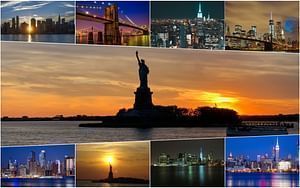
Statue of Liberty Boat Cruise & Walking Tours
Discover our tours, christmas spectacular starring the radio city rockettes tickets 3rd mezz -2023, holiday windows in nyc, new york city 1-hour holiday cruise with santa claus and more, statue of liberty & ellis island ticket & roundtrip ferry, 60-minute statue of liberty sightseeing cruise, statue of liberty and ellis island ferry ticket optional upgrade, nyc skyline: harbor lights night sightseeing cruise, one world observatory tickets, 9/11 memorial museum, edge observation deck entrance ticket, top of the rocks, metropolitan museum of art self guide or guided tour option, statue of liberty, ellis island skip-the-line priority ferry tour, statue of liberty express preferry ticket, statue of liberty and ellis island sunset cruise, statue of liberty reserve ticket with roundtrip ferry, cruise around statue of liberty & manhattan skyline pier 36, new york city sky line & statue of liberty sightseeing cruise pier 36, new york: 60-minute landmarks cruise check in at boat, statue of liberty and ellis island: skip-the-line tickets & round trip ferry, statue of liberty sightseeing cruise 60 min, statue of liberty sunset sightseeing cruise & new york city sky line pier 36, statue of liberty, ellis island & round trip ferry, statue of liberty, ellis island, and 9/11 memorial pools guided tour, nyc: 90-minute architectural skyline boat tour & statue of liberty, statue of liberty guided tour & one day double decker hop on hop off city tour, statue of liberty and ellis island guided french language tour, 9/11 memorial museum entrance & statue of liberty cruise, cruise around statue of liberty & manhattan skyline pier 36 - groups of 10 or more, go city all inclusive new york - 1 day ticket, go city all inclusive new york - 3 day ticket, ground zero 9/11 memorial pools & wall street tour, nyc skyline lights happy hour and cash bar, guided admission to modern art and metropolitan museums in nyc, nyc combo: statue of liberty cruise, st patrick's cathedral & moma entrance, hard rock new york city usa, new york citypass, nyc combo: edge observation deck, st patrick's cathedral and statue of liberty 60 min cruise, nyc combo: statue of liberty cruise & st patrick's cathedral, statue of liberty ellis island cruise with one world trade ticket, statue of liberty, ellis island, and brooklyn bridge after hour cruise, statue of liberty and ellis island tour in spanish, skip-the-line moma museum, statue of liberty & st patrick's cathedral with audio, new york city high-line & hudson yards walking tour, new york christmas tour with private guide, 9/11 memorial, statue of liberty, and ellis island tour.
Statue of Liberty boat specialized in sightseeing tours to the Statue of Liberty and Ellis Island plus ground zero and the 911 memorial pools and ground zero. Operating guided tours of New York City. Sightseeing cruises for 60 minutes and 90 minutes departing from Pier 36 located at 299 South Street directly under the Manhattan Bridge and the Brooklyn Bridge. Lady Liberty statue of liberty cruises operate daily. We partner with top landmarks 911 Memorial Museum, One World Trade Observation, The Edge located at Hudson Yard, Top of the Rocks, Metropolitan Museum. We are a charter partner of St Patricks Cathedral located on 5th ave in Rockefeller center.
Reviews from Tripadvisor
Contact info, +1 2125120515, [email protected], 1 battery pl, new york, 10004, usa, useful links.
- Skip to main content
- Skip to primary sidebar
- Skip to footer

How To Visit Ellis Island in 2024: Tickets, Hours, Tours, and More
Emilie Murphy Last Updated: October 26, 2023
Around 12 million immigrants passed through Ellis Island, just off New York City, in search of a better life. Since then, it’s become a popular tourist destination for visitors and locals alike. But since it’s an island, you might need help understanding how to get there. Here’s how to plan a perfect visit to Ellis Island, plus all the important details about tickets, hours, and more!
Pro Tip: Planning your trip to NYC? Bookmark this post in your browser so you can easily find it when you’re in the city. See our guide to New York City for more planning resources, our best NYC tours for a memorable trip, and the top things to do in NYC .
Visiting Ellis Island: What We’ll Cover
Though it’s only 27.5 acres in size, Ellis Island has played a huge role in American history. During its time as the nation’s major immigration center on the East Coast (from 1892 to 1954), Ellis Island processed over 12 million immigrants, according to the National Park Service.
Many visitors have family members who passed through this famous island to begin their dream of living in America. Even if your family didn’t immigrate through Ellis Island, it’s a remarkable place to visit. Here’s what we’ll cover in this article that’s all about how to visit Ellis Island.
- Opening hours and tickets
- How long to budget for your visit
- How to get there
- What to see and do
- Guided tour options
- Facts and history of Ellis Island
Ellis Island Opening Hours and Tickets
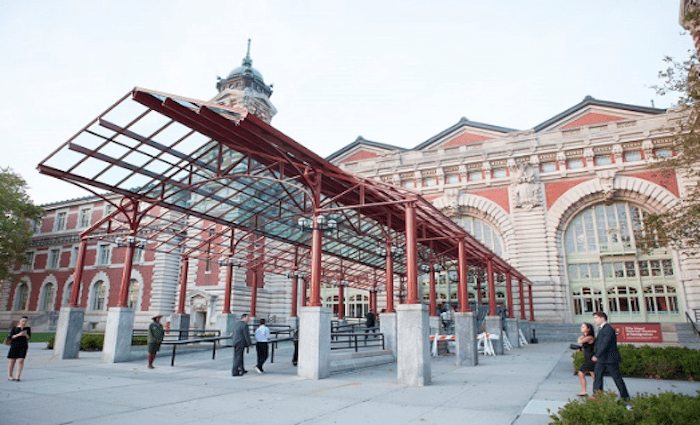
Opening Hours:
Open Sunday – Monday, 9:30 am to 4:30 pm. The History Center on Ellis Island is also open during the day from 10 am to 3:30 pm. The Statue of Liberty and Ellis Island are only closed on Thanksgiving Day and Christmas Day.
To purchase ferry tickets, you can buy them either in person at box offices located within Castle Garden at Battery Park, online, or by booking with a tour agency.
Pro Tip: Ferry tickets can be purchased up to 6 months in advance, so save yourself time waiting in line and make sure you can visit when you’re here!
Did you know tickets for admittance to Ellis Island or Liberty Island (and on-site attractions) are not required? Tickets are required, however, for the ferries that transport tourists to and from both sites. Ferries depart every 20 to 30 minutes, though timetables change depending on the season.
General Admission: $24.50 per adult, $12 for Children 4-12, $18 for seniors (62+)
Other ticket options that offer special tours are also available at a higher price. These include a hard hat tour of Ellis Island and access to the Statue of Liberty pedestal.
Departure address: Castle Clinton National Monument, Battery Park – Liberty Island, New York, NY
Not ready to book a tour? Check out our New York Guide for more resources.
How Much Time To Budget For Ellis Island
Short Answer: 2 to 4 hours for both islands and their museums. This includes the ferry ride and time spent on the island.
Pro Tip: If you have the time, you should see Ellis Island and the Statue of Liberty together. The ferry lines and scheduling make it easier to group the two together, and the history of the two places comes alive when seen as a pair. If you opt for both, we advise you budget at least 3 hours for the entire round-trip experience. Of course, if you’ve bought tickets ahead of time that let you skip the line, you’ll save time on the front end too!
Most Popular New York Tours
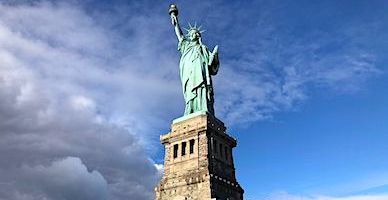
Best Selling Tour
Before the Crowds Statue of Liberty and Ellis Island Tour
Join us on an epic journey through American history! On this tour you will visit the Statue of Liberty and Ellis Island with roundtrip ferry transport included all with a local guide who will describe the city’s amazing history as you visit the picturesque monument.
Top Rated Tour
The New York Met Unveiled: Guided Tour
Visit the most visited art museum in America! You will find artwork from all the world from amazing sculptures to emotional paintings. Your local tour guide will also unveil the secrets of the artists themselves!
Not ready to book a tour? Check out how to spend 3 days in New York .
How To Get to Ellis Island From New York City
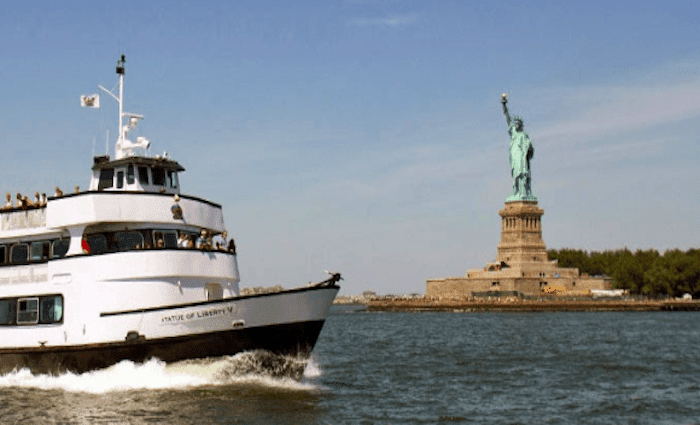
As its name might suggest, Ellis Island is only available by ferry. There are two ferries that transport visitors to and from both Liberty and Ellis islands, one leaving from Jersey City, NJ, the other from Battery Park in downtown NYC. However, getting to the ferry also takes advance planning, and there are several ways to do so.
There are multiple trains that can take visitors down to Battery Park to grab the ferry. Options include taking Local 1 (7th Avenue Line on New York’s West Side) to the last stop, which is South Ferry; grabbing the Express 4 or 5 trains (Lexington Avenue Line on the East Side) to Bowling Green; or the Local R/W train from Brooklyn/Queens (Broadway Line) to Whitehall Street.
Take the M1, M6 or M15 bus lines to South Ferry. It’s the last stop on all three routes, so you can’t miss it!
If you’re coming from the east side, take the FDR Drive South to Exit 1, South Ferry/Battery Park. If coming from the west side, take the Westside Highway South (Route 9A) to Battery Park.
Pro Tip: Parking is always a challenge in NYC. Save yourself the headache and opt for public transportation to and from the ferry docks.
What to See and Do At Ellis Island
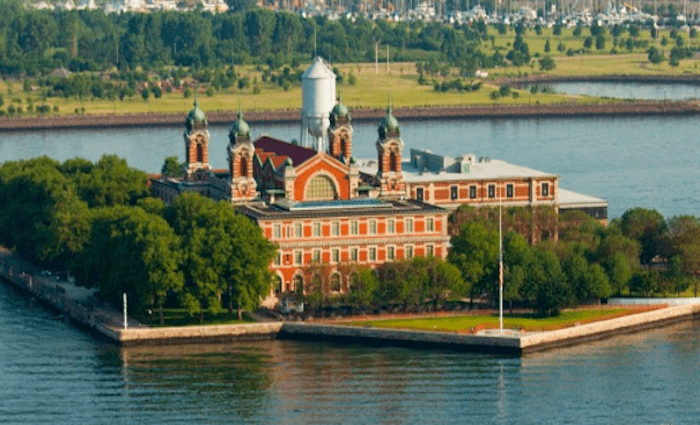
Once you’re on Ellis Island, there are a few must-visit sites. For more in-depth descriptions, history, and images, check out our article on the top things to see at Ellis Island.
- Ellis Island Immigration Museum
- The Wall of Honor
- The Family History Center
- Contagious Infectious Disease Hospital of Ellis Island
- Enjoy views of downtown NYC & Liberty Island
Ellis Island and Statue of Liberty Tour Options
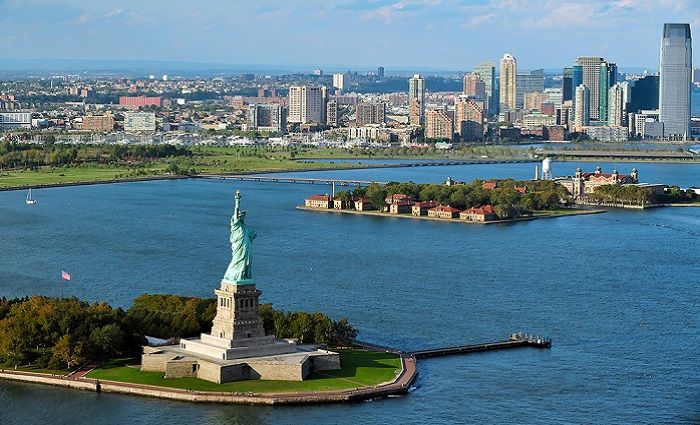
If you’re planning a trip to Ellis Island, you should consider one of our guided tours. This is an easy solution when considering how to visit Ellis Island. As the island is one of the more popular tourist spots in New York City, lines can get very long.
We offer skip-the-line rides at the Statue of Liberty and the Ellis Island ferry line. Our local guides will not only illuminate the history of the place but make the trip smooth and easy.
Join us on an epic journey through American history! On this tour you’ll visit the Statue of Liberty and Ellis Island with roundtrip ferry transport included all with a local guide who will describe the city’s amazing history as you visit the picturesque monument.
See tour itinerary, price, and description
Facts and History Of Ellis Island
To get you excited about your trip, here are some interesting facts about Ellis Island and its history, thanks to the official Statue of Liberty and Ellis Island website. You can also read more about the important history of Ellis Island in our article.
- Ellis Island was originally only 3 acres in size but was expanded through land reclamation projects to its current area of 27.5 acres.
- Ellis Island is named for Manhattan merchant Samuel Ellis who was the original owner in the 1770s.
- The island was owned by the state of New York until 1808 when it was sold to the federal government for immigration purposes.
- During its 62 years of operation, Ellis Island welcomed more than 12 million immigrants into the United States.
- A massive fire in June of 1897 burned the immigration station to the ground. No lives were lost, but immigration records dating back to 1855 were lost.
- Contrary to popular belief, only 2% of arriving immigrants were denied entry to the U.S. at Ellis Island. The main reasons for exclusion were contagious disease diagnoses or concern about an immigrant’s likelihood of becoming a public charge.
- Ellis Island’s busiest year was 1907 when it processed 1.25 million immigrants.
- After World War I, Ellis Island became used as a detainment center for displaced persons, war refugees, or immigrants with paperwork issues.
- In 1954, the US government officially closed Ellis Island after the release of the last remaining detainee, a Norwegian merchant seaman named Arne Peterssen.
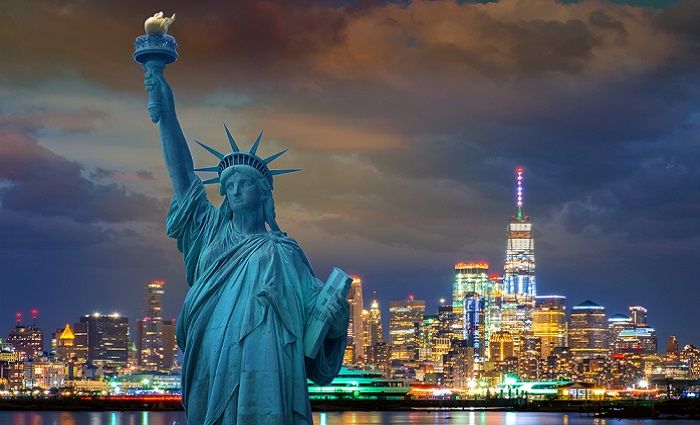
Where to Stay in NYC
New York City is the center of the universe to those who adore this iconic city. Choose the best neighborhood to stay in as you plan your upcoming trip to the Big Apple.
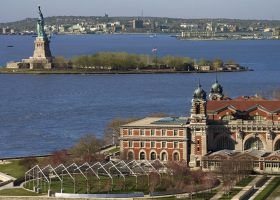
About Emilie Murphy
Reader interactions, leave a comment cancel reply.
Your email address will not be published. Required fields are marked *
- Travel Guide
- In The Press
POLICY & TERMS
- Cancellation Policy
- Terms & Conditions
- Privacy Policy

INTRODUCING the Ellis Island Museum Reimagined Campaign! | CELEBRATE your family story – add a name to the WALL OF HONOR!
Be inspired
Experience the icon in person., ellis island, make the voyage, walk in the footsteps of history., help keep liberty alive..
- Search Passenger and Ship Records
- Views from Lady Liberty
- Let Us Start Your Search!
- Genealogy Tips
- Educational Resources
- Oral History Project
- Famous Names in the Ellis Island Database
- Ellis Island Museum Reimagined
- Become a Member
- Make a Donation
- Wall of Honor
- Founders Registry
- Statue of Liberty Click for more info Overview + History Statue of Liberty Museum The Role of the Foundation The Future of Liberty
- Ellis Island Click for more info Overview + History National Museum of Immigration Family History Center American Immigrant Wall of Honor The Role of the Foundation The Future of Ellis
- Foundation Click for more info Mission + History News Leadership + Governance Awards Our Blog: The Torch Careers
- Visit Click for more info Visit
- Discover Click for more info Search Passenger and Ship Records Views from Lady Liberty Let Us Start Your Search! Genealogy Tips Educational Resources Oral History Project Famous Names in the Ellis Island Database
- Support Click for more info Ellis Island Museum Reimagined Become a Member Make a Donation Wall of Honor Founders Registry
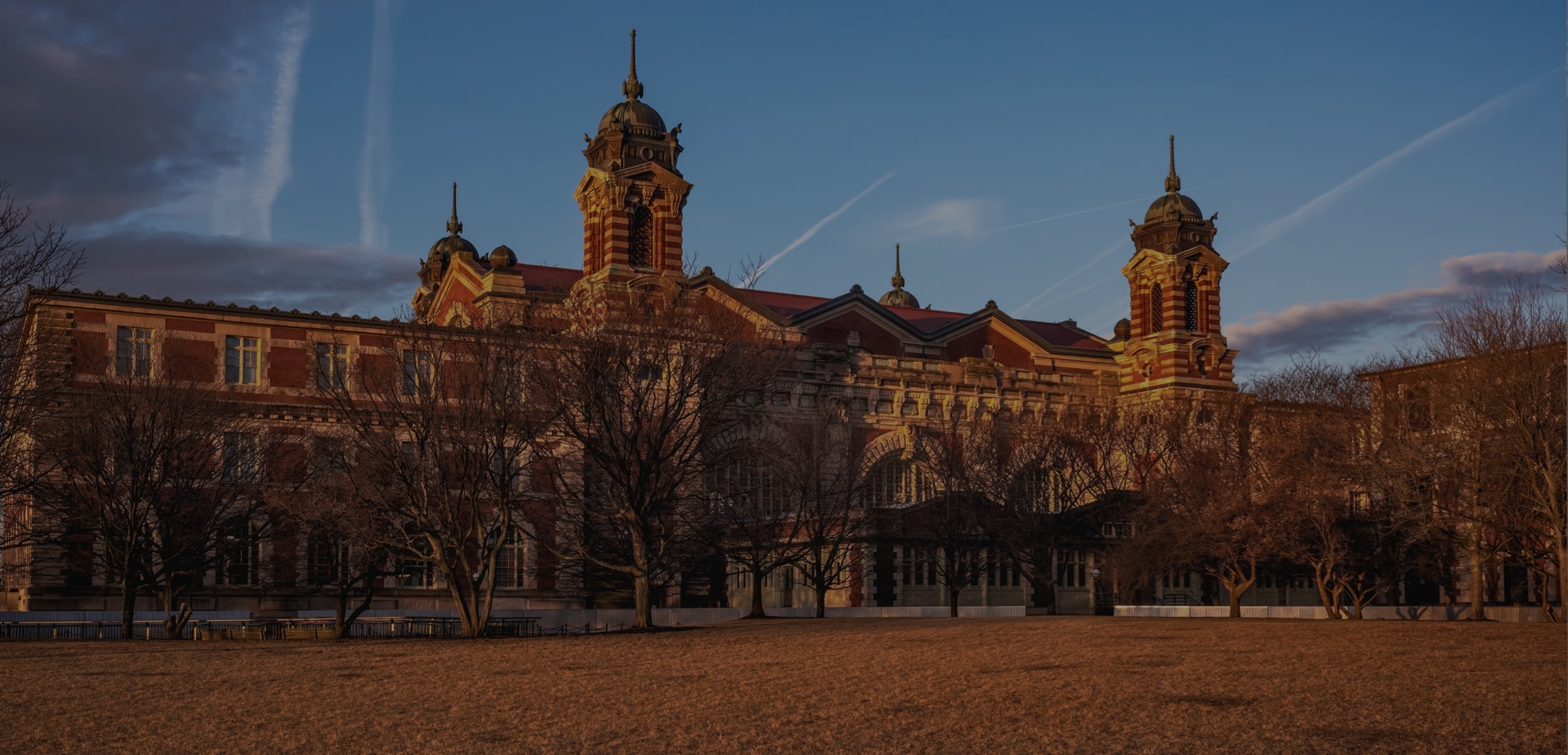
National Immigration Museum
A journey of discovery.
The Ellis Island National Museum of Immigration is a living monument to the story of the American people. Housed inside the restored Main Building of the former immigration complex, the Museum documents the rich story of American immigration through a carefully curated collection of photographs, heirlooms, and searchable historic records.
Visitors touring the Great Hall, baggage room, and restored dormitories can feel the spirit of the hopeful arrivals eager to find opportunity, and the Museum’s interactive exhibits bring their voyages to life. Each display sheds light on the immigration process, and allows visitors to gain an appreciation for the nuances of the American melting pot.
Constantly evolving, the Museum doesn’t end with tales of Ellis Island and its golden doors – it also highlights immigration before and after the Ellis era. Thought-provoking and moving, the Museum celebrates all of those who have searched for promise and possibility and honors the complexities and contradictions of the migrant journey.
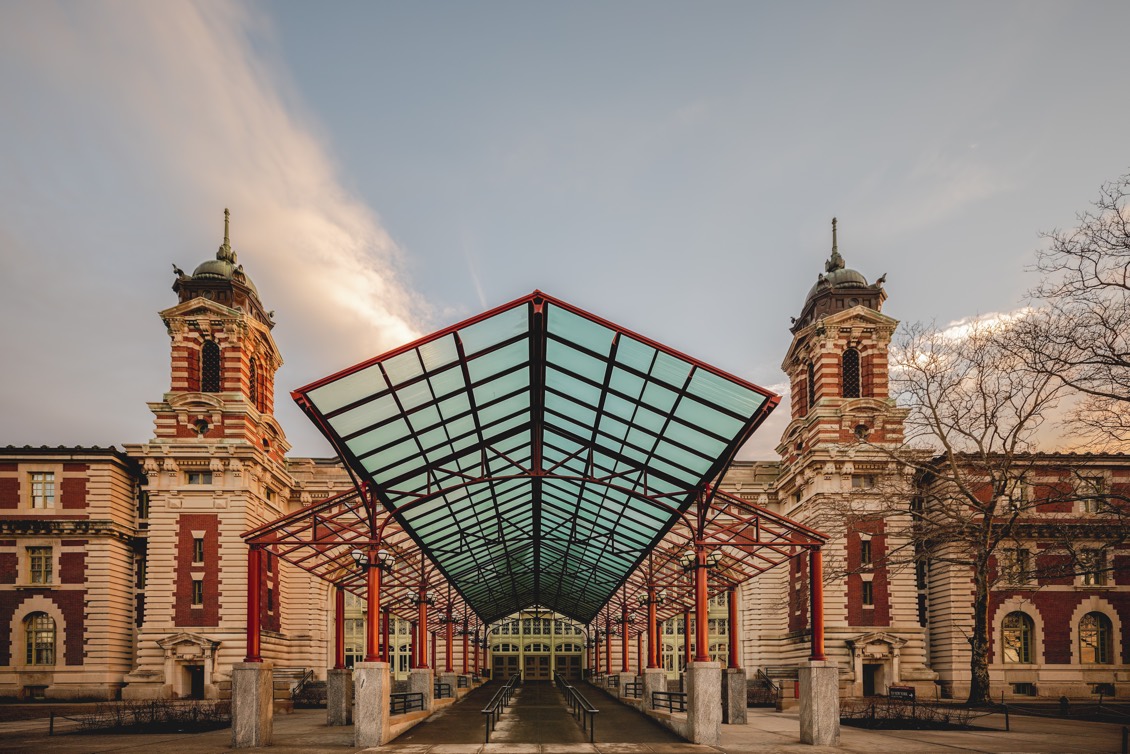
MORE TO EXPLORE
The family history center.
Find your place in history by searching through a massive collection of immigration records. Connect with your ancestors’ experiences, and follow the paths that led them to American soil.
The American Immigrant Wall of Honor
Salute your family and heritage at this unique monument to immigration, and join the Museum in celebrating who we are, and where we came from. Add your family’s name to the Wall of Honor.
Museum Information
The National Immigration Museum traces the story of human movement to tell the story of Who We Are as Americans. We ask visitors to examine their own histories and encourage them to think about where we all fit in the modern world.
A piece of history itself, Ellis Island is both memorial and museum. By welcoming families and visitors to its doors, we create an opportunity for cultural understanding and forge a continuum with our own heritage.
Our mission
Keeping the gates open, create an account.
Already have an account? Sign In
Forgot your password?
Create an account?
Having trouble? Contact Us .
- New York City
- Things to Do
- Restaurants
- Vacation Rentals
- Travel Stories
- Rental Cars
- Add a Place
- Travel Forum
- Travelers' Choice
- Help Center
Hard Hat tour worth it, but plan ahead - Ellis Island
- United States
- New York (NY)
- New York City
- New York City - Things to Do
- Ellis Island
Hard Hat tour worth it, but plan ahead
I was with my 76 year old mother and 14 year old son so I wanted to be sure we had a pleasant experience and were not waiting in line like cattle for too long. We booked the Pedestal and Ellis Island hard hat tour for a Monday morning (the first hard hat tour is offered at 11:30). We arrived to Battery park at 08:30 as suggested on the tickets. There was already a long line and when I showed our tickets with the timed entry the staff member said it did not matter what time was on the ticket, to just wait in line with everyone, I still do not understand the purpose of the timed tickets? We did manage to get on the 09:00 ferry but we were among the last to get on that first boat. Despite feeling very crowded on the boat, walking up to the pedestal and around the statue of liberty did not feel overcrowded. When I asked a park attendant how much time we should allow to get to Ellis island he recommended the 10:35 ferry to Ellis Island and to start waiting in line at 10:20. I am glad we did this as the ferry to Ellis Island was very full (many guests coming from NYC did not get off the ferry at the statue of liberty meaning less space for those guests trying to get from the Statue of Liberty to Ellis Island). I imagine that later in the day or on an even more crowded day you might have to wait for a 2nd ferry so do keep that in mind with timing. I would have liked to explore more around the Statue of Liberty but there was not time for that. We arrived to Ellis Island at 10:55 and checked in for our hard hat tour (signing some papers) and were told to be back at 11:25. We had a quick bit at the cafe as the tour is 90 minutes and there is no food allowed nor bathrooms available. The tour was amazing and well worth it, very informative and interesting, both my mom and my son enjoyed it very much and the 90 minutes flew by. It was a beautiful day but I imagine it could be quite cold on a rainy or windy day so be prepared. When the tour was over we noticed that there was already a large line for the ferry back to NYC. We did not want to wait to get back to NYC as we had plans for the late afternoon so we did a 10 minute run around the immigration museum and then got in line for the ferry. My mother and son were content, however I would really have loved time to explore the museum. It is a shame that you feel stressed to get the ferry knowing that you may have to wait standing ni line for another 25 minutes for another boat if you are not able to get on the next one and I wish they had a better system for reserving times instead of cramming everyone in. I also do not understand the ticketing system. You have to buy separate tickets for the Pedestal/Crown and for the Hard Hat tour so if you do both, you are buying 2 x the ferry from Battery Park to the Statue fo Liberty? There should be a way to buy the ferry then add on the tours as they are sold on the same City Experience website?? One of the top tourist attractions in NYC (one of the most technologically advanced cities in the world) and they have not figured out a better way to sell tickets or make the entire experience smoother?!
This review is more a warning to visitors to New York We arrived in New York last week (15 October) and really wanted to get to Ellis Island. We tried!!! We took the subway own to south ferry and when we emerged we were surrounded by a swarm of hawkers who harassed us into buying tickets to their own ( not what we wanted )tour of the bay. They raised their voices a few times when we tried to walk away and were generally intimidating . They also lied about accessibility to Ellis Island on other tours.said the museum was closed . Still really angry about those guys . Will probably never get the chance to go to Ellis Island. Sad that a city allows these pests and hawkers to operate unmolested. Sort it out New York. These people have left a bad taste. And visitors .. stay strong and walk away.
We caught the ferry across from The Statue of Liberty at about 11 am. It wasn’t too crowded and you basically off load straight into the museum We picked up an audio guide to ensure we learnt everything we could and didn’t miss anything. For us this was the end of a longer journey having visited the Red Star Line Museum in Antwerp where a lot of the European immigrants bought passage to the New World. We didn’t really learn anything new and to be honest found the museum in Antwerp far more informative. Every American should visit to understand that the Native Americans are the only true real Americans. Everyone else is descended from an immigrant and as such should perhaps have more compassion for those seeking a better life in the current age. We were there for several hours and finished our day by taking the ferry back to Battery Park.

Incredible transportation capacity back from Ellis Island. Waited 2h… Will Not recommend that visit even if the history of the Location is interesting
Great experience, very educational. 2 hours just fly by. So much to observe. As We are facing immigration issues today, we can all revisit here Ellis island to see how our country was formed and know what your great grand parents experienced. Be educated, be smart and compassionate. My 18 years old daughter spend much time just learning how USA formed by immigrants from all over the world. She says what she learned in school finally connected, and able to deepen her understanding of this country. After visit here, you can go back to Manhattan with fresh pair of eyes to see everyone’s life and being. Wished cafeteria offers different types of food, commemorate different ethnic foods.
Better than visiting Statue of Liberty. Most locals recommend to visit this before Statue of Liberty and I would definitely agree. That is if you want pictures with less strangers in them. It normally is never super crowded either.
- History Classics
- Your Profile
- Find History on Facebook (Opens in a new window)
- Find History on Twitter (Opens in a new window)
- Find History on YouTube (Opens in a new window)
- Find History on Instagram (Opens in a new window)
- Find History on TikTok (Opens in a new window)
- This Day In History
- History Podcasts
- History Vault
Ellis Island
By: History.com Editors
Updated: February 13, 2023 | Original: October 27, 2009

Ellis Island is a historical site that opened in 1892 as an immigration station, a purpose it served for more than 60 years until it closed in 1954. Located at the mouth of Hudson River between New York and New Jersey, Ellis Island saw millions of newly arrived immigrants pass through its doors. In fact, it has been estimated that close to 40 percent of all current U.S. citizens can trace at least one of their ancestors to Ellis Island.
U.S. Immigration History

When Ellis Island opened, a great change was taking place in U.S. immigration . Fewer arrivals were coming from northern and western Europe—Germany, Ireland, Britain and the Scandinavian countries—as more and more immigrants poured in from southern and eastern Europe.
Among this new generation were Jews escaping from political and economic oppression in czarist Russia and eastern Europe and Italians escaping poverty in their country. There were also Poles, Hungarians, Czechs, Serbs, Slovaks and Greeks, along with non-Europeans from Syria , Turkey and Armenia.
The reasons they left their homes in the Old World included war, drought, famine and religious persecution, and all had hopes for greater opportunity in the New World.
After an arduous sea voyage, immigrants arriving at Ellis Island were tagged with information from their ship’s registry; they then waited on long lines for medical and legal inspections to determine if they were fit for entry into the United States.
From 1900 to 1914—the peak years of Ellis Island’s operation—an average of 1,900 people passed through the immigration station every day. Most successfully passed through in a matter of hours, but others could be detained for days or weeks.
Many immigrants remained in New York , while others traveled by barge to railroad stations in Hoboken or Jersey City, New Jersey , on their way to destinations across the country.
Ellis Island Museum of Immigration
Passage of the Emergency Quota Act of 1921 and the National Origins Act of 1924, which limited the number and nationality of immigrants allowed into the United States, effectively ended the era of mass immigration into New York City . At this point, the smaller number of immigrants began to be processed on their arriving ships, with Ellis Island serving primarily as a temporary detainment center.
From 1925 to the closing of Ellis Island in 1954, only 2.3 million immigrants passed through the New York City port–which still represented more than half of all those entering the United States.
Ellis Island opened to the public in 1976. Today, visitors can tour the Ellis Island Museum of Immigration in the restored Main Arrivals Hall and trace their ancestors through millions of immigrant arrival records made available to the public in 2001.
In this way, Ellis Island remains a central destination for millions of Americans seeking a glimpse into the history of their country, and in many cases, into their own family’s story.
Ellis Island Timeline
1630-1770 Ellis Island is little more than a spit of sand in the Hudson River, located just south of Manhattan. The Native Americans of the Mohegan tribe who lived on the nearby shores call the island Kioshk, or Gull Island. In 1630, the Dutch acquired the island and gifted it to a certain Michael Paauw, who called it Oyster Island for the plentiful amounts of shellfish on its beaches.
During the 1760s, it is known as Gibbet Island, for its gibbet, or gallows tree, used to hang men convicted of piracy .
1775-1865 Around the time of the Revolutionary War , the New York merchant Samuel Ellis purchases the island, and builds a tavern on it that caters to local fishermen.
Ellis dies in 1794, and in 1808 New York State buys the island for $10,000. The U.S. War Department pays the state for the right to use Ellis Island to build military fortifications and store ammunition, beginning during the War of 1812 . Half a century later, Ellis Island is used as a munitions arsenal for the Union army during the Civil War .
Meanwhile, the first federal immigration law, the Naturalization Act , is passed in 1790; it allows all white males living in the U.S. for two years to become citizens. There is little regulation of immigration when the first great wave begins in 1814.
Nearly 5 million people will arrive from northern and western Europe over the next 45 years. Castle Garden, one of the first state-run immigration depots, opens at the Battery in lower Manhattan in 1855. The Potato Famine that strikes Ireland (1845-52) leads to the immigration of about 1 million Irish alone in the next decade.
Concurrently, large numbers of Germans flee political and economic unrest. Rapid settlement of the West begins with the passing of the Homestead Act in 1862. Attracted by the opportunity to own land, more Europeans begin to immigrate.
1865-1892 After the Civil War, Ellis Island stands vacant, until the government decides to replace the New York immigration station at Castle Garden, which closes in 1890. Control of immigration is turned over to the federal government, and $75,000 is appropriated for construction of the first federal immigration station on Ellis Island.
Artesian wells are dug and the island’s size is doubled to over six acres, with landfill created from incoming ships’ ballast and the excavation of New York City subway tunnels.
Beginning in 1875, the United States forbids prostitutes and criminals from entering the country. The Chinese Exclusion Act is passed in 1882. Also restricted are “lunatics” and “idiots.”
1892 The first Ellis Island Immigration Station officially opens on January 1, 1892, as three large ships wait to land. Seven hundred immigrants passed through Ellis Island that day, and nearly 450,000 followed over the course of that first year.
Over the next five decades, more than 12 million people will pass through the island on their way into the United States.
1893-1902 On June 15, 1897, with 200 immigrants on the island, a fire breaks out in one of the towers in the main building and the roof collapses. Though no one is killed, all Ellis Island records dating back to 1840 and the Castle Garden era are destroyed. The immigration station is relocated to the barge office in Manhattan’s Battery Park.
The new fireproof facility is officially opened in December 1900, and 2,251 people pass through on opening day. President Theodore Roosevelt appoints a new commissioner of immigration, William Williams, who cleans house on Ellis Island beginning in 1902 by overhauling operations and facilities.
To eliminate corruption and abuse, Williams awards contracts based on merit and announces contracts will be revoked if any dishonesty is suspected. He imposes penalties for any violation of this rule and posts “Kindness and Consideration” signs as reminders to workers.
1903-1910 To create additional space at Ellis Island, two new islands are created using landfill. Island Two houses the hospital administration and psychiatric ward, while Island Three holds the contagious diseases ward.
By 1906, Ellis Island has grown to more than 27 acres, from an original size of only three acres.
Anarchists are denied admittance into the United States as of 1903. On April 17, 1907, an all-time daily high of 11,747 immigrants received is reached; that year, Ellis Island experiences its highest number of immigrants received in a single year, with 1,004,756 arrivals.
A federal law is passed excluding persons with physical and mental disabilities, as well as children arriving without adults.
1911-1919 World War I begins in 1914, and Ellis Island experiences a sharp decline in receiving immigrants: From 178,416 in 1915, the total drops to 28,867 in 1918.
Anti-immigrant sentiment increases after the U.S. enters the war in 1917; German citizens seized on ships in East Coast ports are held at Ellis Island before being deported.
Starting in 1917, Ellis Island operates as a hospital for the U.S. Army, a way station for Navy personnel and a detention center for enemy aliens. By 1918, the Army takes over most of Ellis Island and creates a makeshift way station to treat sick and wounded American servicemen.
The literacy test is introduced at this time, and stays on the books until 1952. Those over the age of 16 who cannot read 30 to 40 test words in their native language are no longer admitted through Ellis Island. Nearly all Asian immigrants are banned.
At war’s end, a “ Red Scare ” grips America in reaction to the Russian Revolution . Ellis Island is used to intern immigrant radicals accused of subversive activity; many of them are deported.
1920-1935 President Warren G. Harding signs the Emergency Quota Act into law in 1921. According to the new law, annual immigration from any country cannot exceed 3 percent of the total number of U.S. immigrants from that same country, as recorded in the U.S. Census of 1910.
The Immigration Act of 1924 goes even further, setting strict quotas for immigrants based on country of origin, including an annual limit of 165,000 immigrants from outside the Western Hemisphere.
The buildings on Ellis Island begin to fall into neglect and abandonment. America is experiencing the end of mass immigration. By 1932, the Great Depression has taken hold in the U.S., and for the first time ever, more people leave the country than arrive.
1949–1955 By 1949, the U.S. Coast Guard has taken over most of Ellis Island, using it for office and storage space. The passage of the Internal Security Act of 1950 excludes arriving immigrants with previous links to communist and fascist organizations. With this, Ellis Island experiences a brief resurgence in activity. Renovations and repairs are made in an effort to accommodate detainees, who sometimes number 1,500 at a time.
The Immigration and Naturalization Act of 1952 (also known as the McCarran–Walter Act ), combined with a liberalized detention policy, causes the number of detainees on the island to plummet to fewer than 30 people.
All 33 structures on Ellis Island are officially closed in November 1954.
In March 1955, the federal government declares the island surplus property; it is subsequently placed under the jurisdiction of the General Services Administration.
1965-1976 In 1965, President Lyndon B. Johnson issues Proclamation 3656, according to which Ellis Island falls under the jurisdiction of the National Park Service as part of the Statue of Liberty National Monument.
Also in 1965, President Johnson signs the Immigration and Naturalization Act of 1965 , also known as the Hart-Celler Act, which abolishes the earlier quota system based on national origin and establishes the foundations for modern U.S. immigration law.
The act allows more individuals from third-world countries to enter the U.S. (including Asians, who have in the past been barred from entry) and establishes a separate quota for refugees.
Ellis Island opens to the public in 1976, featuring hour-long guided tours of the Main Arrivals Building. During this year, more than 50,000 people visit the island.
1982-1990 In 1982, at the request of President Ronald Reagan , Lee Iacocca of the Chrysler Corporation heads the Statue of Liberty-Ellis Island Foundation to raise funds from private investors for the restoration and preservation of Ellis Island and the Statue of Liberty.
By 1984, when the restoration begins, the annual number of visitors to Ellis Island has reached 70,000. The $156 million dollar restoration of Ellis Island’s Main Arrivals Building is completed and re-opened to the public in 1990, two years ahead of schedule.
The Main Building houses the new Ellis Island Immigration Museum, in which many of the rooms have been restored to the way they appeared during the island’s peak years. Since 1990, some 30 million visitors have visited Ellis Island to trace the steps of their ancestors.
Meanwhile, immigration into the United States continues, mostly by land routes through Canada and Mexico . Illegal immigration becomes a source of political debate throughout the 1980s and 1990s. More than 3 million aliens receive amnesty through the Immigration Reform Act in 1986, but an economic recession in the early 1990s is accompanied by a resurgence of anti-immigrant feeling.
1998 In 1998, the U.S. Supreme Court rules that New Jersey has authority over the south side of Ellis Island, or the section composed of the landfill added since the 1850s. New York retains authority over the island’s original 3.5 acres, which includes the bulk of the Main Arrivals Building.
The policies put into effect by the Immigration and Naturalization Act of 1965 have greatly changed the face of the American population by the end of the 20th century. Whereas in the 1950s, more than half of all immigrants were Europeans and just 6 percent were Asians, by the 1990s only 16 percent are Europeans and 31 percent are Asians, and the percentages of Latino and African immigrants also jump significantly.
Between 1965 and 2000, the highest number of immigrants (4.3 million) to the U.S. comes from Mexico; 1.4 million are from the Philippines. Korea, the Dominican Republic, India, Cuba and Vietnam are also leading sources of immigrants, each sending between 700,000 and 800,000 over this period.
2001 The American Family Immigration History Center (AFIHC) opens on Ellis Island in 2001. The center allows visitors to search through millions of immigrant arrival records for information on individual people who passed through Ellis Island on their way into the United States.
The records include the original manifests, given to passengers onboard ships and showing names and other information, as well as information about the history and background of the ships that arrived in New York Harbor bearing hopeful immigrants to the New World.
Debates continue over how America should confront the effects of rising immigration rates throughout the 1990s. In the wake of the 9/11 terrorist attacks , the Homeland Security Act of 2002 creates the Department of Homeland Security (DHS), which takes over many immigration service and enforcement functions formerly performed by the Immigration and Naturalization Service (INS).
2008-Present In 2008, plans are announced for an expansion of the Ellis Island Immigration Museum called “The Peopling of America,” which opened to the public on May 20, 2015. The museum’s exploration of the Ellis Island era (1892-1954) was expanded to include the entire American immigration experience up to the present day.
The First Arrival On January 1, 1892, teenager Annie Moore from County Cork, Ireland, became the first person admitted to the new immigration station on Ellis Island. On that opening day, she received a greeting from officials and a $10.00 gold piece. Annie traveled to New York with her two younger brothers on steerage aboard the S.S. Nevada , which left Queenstown (now Cobh), Ireland, on December 20, 1891 and arrived in New York on the evening of December 31. After being processed, the children were reunited with their parents, who were already living in New York.
Beware the Buttonhook Men Doctors checked those passing through Ellis Island for more than 60 diseases and disabilities that might disqualify them from entry into the United States. Those suspected of being afflicted with a having a disease or disability were marked with chalk and detained for closer examination. All immigrants were checked closely for trachoma, a contagious eye condition that caused more detainments and deportations than any other ailment. To check for trachoma, the examiner used a buttonhook to turn each immigrant’s eyelids inside out, a procedure remembered by many Ellis Island arrivals as particularly painful and terrifying.
Dining at Ellis Island Food was plentiful at Ellis Island, despite various opinions as to its quality. A typical meal served in the dining hall might include beef stew, potatoes, bread and herring (a very cheap fish); or baked beans and stewed prunes. Immigrants were introduced to new foods, such as bananas, sandwiches and ice cream, as well as unfamiliar preparations. To meet the special dietary requirements of Jewish immigrants, a kosher kitchen was built in 1911. In addition to the free meals served, independent concessions sold packaged food that immigrants often bought to eat while they waited or take with them when they left the island.
Famous Names Many famous figures passed through Ellis Island, some leaving their original names behind on their entry into the U.S. Israel Beilin–better known as composer Irving Berlin –arrived in 1893; Angelo Siciliano, who arrived in 1903, later achieved fame as the bodybuilder Charles Atlas. Lily Chaucoin arrived from France to New York in 1911 and found Hollywood stardom as Claudette Colbert . Some were already famous when they arrived, such as Carl Jung or Sigmund Freud (both 1909), while some, like Charles Chaplin (1912) would make their name in the New World.
A Future Mayor Fiorello La Guardia , the future mayor of New York City, worked as an interpreter for the Immigration Service at Ellis Island from 1907 to 1910, while he was completing law school at New York University. Born in New York in 1882 to immigrants of Italian and Jewish ancestry, La Guardia lived for a time in Hungary and worked at the American consulates in Budapest and other cities. From his experience at Ellis Island, La Guardia came to believe that many of the deportations for so-called mental illness were unjustified, often due to communication problems or to the ignorance of doctors doing the inspections.
“I’m Coming to New Jersey” After the Supreme Court ruled in 1998 that the state of New Jersey, not New York, had authority over the majority of the 27.5 acres that make up Ellis Island, one of the most vocal New York boosters, then-Mayor Rudolph Giuliani , famously remarked of the court’s decision: “They’re still not going to convince me that my grandfather, when he was sitting in Italy, thinking of coming to the United States, and on the shores getting ready to get on that ship in Genoa, was saying to himself, ‘I’m coming to New Jersey.’ He knew where he was coming to. He was coming to the streets of New York.”

HISTORY Vault
Stream thousands of hours of acclaimed series, probing documentaries and captivating specials commercial-free in HISTORY Vault
Closing the Door on Immigration. National Park Service . Ellis Island. The Statue of Liberty—Ellis Island Foundation, Inc . Ellis Island. UNESCO World Heritage Convention . Topics in Chronicling America - Ellis Island. Library of Congress . Immigration and Deportation at Ellis Island. PBS: American Experience .

Sign up for Inside History
Get HISTORY’s most fascinating stories delivered to your inbox three times a week.
By submitting your information, you agree to receive emails from HISTORY and A+E Networks. You can opt out at any time. You must be 16 years or older and a resident of the United States.
More details : Privacy Notice | Terms of Use | Contact Us
Immigration | Stories of Yesterday and Today
A new land 1492-1790.
Expanding America 1790-1880
The american dream 1880-1930, a place of refuge 1930-1965.

Building a Modern America 1965-Today
The beautiful land of the New World amazed the European explorers who arrived on North American shores around 1500. They realized the economic possibilities of the fertile soil and many natural resources. In the 17th century, Europeans established successful permanent settlements in what is now the United States. The European settlers soon dominated the Native American civilizations, which had existed for thousands of years. The major European powers (including England, Spain, and France) established colonies,
which are lands controlled by a faraway government. The people who lived in the colonies were called colonists. Enduring great hardship, the colonists built new communities in the New World
The Explorers
In 1492, Christopher Columbus, an Italian explorer and excellent sailor, crossed the Atlantic Ocean in search of a shorter trade route to Asia. After more than two months at sea, he landed in the Bahamas in the Caribbean islands. Although Columbus never reached the mainland of North America, he had discovered the gateway to a vast continent unexplored by Europeans. Columbus returned to Europe believing he had reached previously unknown islands in Asia. Word of the new route spread in Europe. Over the next few decades, other explorers followed in Columbus's wake, hoping to take advantage of the shortcut to Asia. It would be another Italian explorer, named Amerigo Vespucci, who realized that what had actually been discovered was a continent unknown to Europeans. He called it the New World.
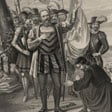
New Settlements
European nations—including Spain, France, the Netherlands, Portugal, Sweden, and England—vied to claim pieces of the new land. In the 1600s, England founded colonies along the Atlantic seaboard, from what is now New Hampshire to Georgia. These original 13 colonies would eventually become the United States of America. Spain founded a colony at Saint Augustine, Florida, as early as 1565 and would go on to claim parts of what are now the states of Texas, New Mexico, Arizona, and California. France established colonies along the Saint Lawrence River, in what is now Canada; and also in the southern part of North America, in the region that is now Louisiana. The Dutch began the settlement of New Amersterdam on the southern tip of what is now Manhattan Island, home to part of New York City. The European countries often fought each over ownership of the new land; more land meant more power and economic opportunity.
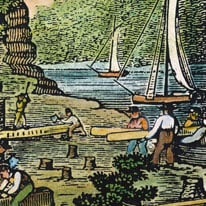
Jamestown Succeeds
In 1607, England sent 100 men to America to found a new colony. The colony was named Jamestown after King James I and was located on the coast of what is now Virginia. It would become the first English colony to succeed in America, but its beginning was exceptionally difficult. The colonists were hoping to find gold easily, but didn't. And tragically, they hadn't anticipated how hard it would be to survive in the New World. More than half of the settlers died in the first year because of the harsh winters, poor planning, and disease. But under the leadership of the colonist John Smith, the colony began to succeed. They grew tobacco, which was sent back to England and sold for profit. With the profit, the colonists had the money to plant other crops, such as wheat, grapes, and corn, which is a food native to North America. By 1620, Jamestown plus other settlements that sprang up nearby had a population of about 4,000. The colony was thriving. This economic success gave England a powerful interest in protecting its foothold in the New World.
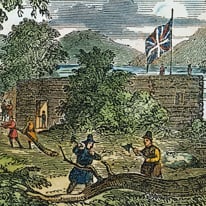
Slavery Begins
Africans first arrived in North America in 1619. In that year, 20 African people were brought to the Jamestown colony aboard a Dutch warship. They were slaves. They had been taken from their homes in Africa by force. They were beaten and enchained by men carrying weapons. Over the next almost 200 years, hundreds of thousands of Africans would be brought to America as slaves to work on plantations, especially to grow tobacco. By the end of the colonial period, Africans numbered about 500,000 and formed about 20 percent of the population of the United States.
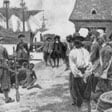
The Pilgrims
Some colonies were formed because people wanted to escape religious persecution in Europe. In 17th century England, two groups of Christians, the Catholics and the Anglicans, were arguing over what religion and church should be the true church of England. Some of the Anglicans, called Puritans, thought that there should be more distinction between their Church of England and the Catholic Church. Some Puritans, called the Separatists, didn't want to belong to the Church of England at all anymore. King James, who was the head of the Church of England, would not allow the Separatists to practice religion on their own. To escape the situation in England, a small group of Separatists left Europe on the Mayflower ship. In 1620, the ship landed at what is now Plymouth, Massachusetts, carrying 102 passengers. Many were Separatists, who became known as the Pilgrims. They established Plymouth Colony. After the Pilgrims, many more people flocked to the new colonies for religious reasons: About 200,000 Puritans emigrated from England during the years 1620 to 1641.
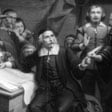
Religious Freedom
After the Pilgrims, many other immigrants came to America for the religious freedom it offered. The colony of Maryland was founded in 1634 as a refuge for Catholics, who were persecuted in England in the 17th century. In 1681, William Penn began a Quaker colony in the land that was later named after him: Pennsylvania. The main settlement was Philadelphia, which prospered through farming and commerce. In 1685, 14,000 Huguenots who were persecuted in France also joined the growing English colonies.
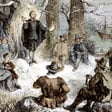
Expanding Colonies
Early immigrants to America settled up and down the East Coast. Farming was difficult in the rocky soil of New England, so people grew only enough food for their families to live on. This is called subsistence farming. They also became fishermen, fishing cod in the Atlantic Ocean and selling it to the European markets. As they needed good ships for fishing, they started making them, becoming successful shipbuilders. In the South, where farming was easier, colonists started large plantations to grow crops, such as tobacco, rice, and indigo. Indigo was a rich blue dye, mainly used for dyeing textiles. Plantations depended on the free labor of the slaves. Many more slaves were forced to come to America to meet the demand for labor. By the time of the Revolutionary War, about 2.5 million people lived in the colonies, including approximately 450,000 Africans; 200,000 Irish; 500,000 Scottish and Scotch-Irish; 140,000 Germans; and 12,000 French.
As the colonies grew, people began to look past the natural barrier of the Appalachian Mountains. They moved west into the frontier lands, in what is now Ohio, and beyond.
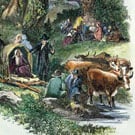
A New Nation
The colonies grew prosperous and the population increased. Between the time of the first settlements and the Revolutionary War, about seven generations of people were born in America. Many of them no longer wanted to be ruled by the English throne. And they didn't want to pay taxes to the English government when they had no colonial representation in the Parliament. They became known as Patriots, or Whigs, and they included Thomas Jefferson and John Adams. The Loyalists were colonists who wanted to remain part of England. The Patriots and Loyalists were bitterly divided on the issue. In 1776, the Continental Congress, a group of leaders from each of the 13 colonies, issued the Declaration of Independence. The Declaration stated that the United States of America was its own country. The Patriots fought England in the Revolutionary War to gain independence for the colonies.
In 1783, with the help of the French, who had joined their side, the colonists won the war. The United States of America was a new nation. The new government conducted a census, or count, of everyone living in the United States. At the time of the first census in 1790, nearly 700,00 Africans and 3 million Europeans lived in the new United States.
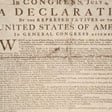
- The Americas
In the decades after the Revolutionary War, the 13 original colonies grew to include states stretching from Maine in the north to Louisiana in the south; from the Atlantic Ocean in the east to Illinois in the west. As a new nation, the United States of America thrived. By 1820, the population had grown to nearly 10 million people. The quality of life for ordinary people was improving. People were moving west, creating towns along the route of the Transcontinental Railroad, which connected the entire country by rail, east to west, for the first time.
The prosperous young country lured Europeans who were struggling with population growth, land redistribution, and industrialization, which had changed the traditional way of life for peasants. These people wanted to escape poverty and hardship in their home countries. More than 8 million would come to the United States from 1820 to 1880.
Slavery Continues
At the turn of the 19th century, more than 1 million African Americans lived in the United States. As slaves, they were not considered citizens. Large farms and plantations depended on the free labor they provided in fields and homes. It was difficult, backbreaking work. In 1808, the United States government banned the importation of enslaved people into the country, although the practice did continue illegally. Slavery, however, was not abolished for nearly 60 more years.
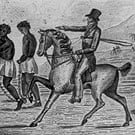
The Irish and Germans
In the early and mid-19th century, nearly all of the immigrants coming to the United States arrived from northern and western Europe. In 1860, seven out of 10 foreign-born people in the United States were Irish or German. Most of the Irish were coming from poor circumstances. With little money to travel any further, they stayed in the cities where they arrived, such as Boston and New York City. More than 2,335,000 Irish arrived between 1820 and 1870. The Germans who came during the time period were often better off than the Irish were. They had enough money to journey to the Midwestern cities, such as Chicago, Cincinnati, and St. Louis, or to claim farmland. More than 2,200,000 Germans arrived between 1820 and 1870.

The Irish Potato Famine
In 1845, a famine began in Ireland. A potato fungus, also called blight, ruined the potato crop for several years in a row. Potatoes were a central part of the Irish diet, so hundreds of thousands of people now didn't have enough to eat. At the same time of the famine, diseases, such as cholera, were spreading. Starvation and disease killed more than a million people. These extreme conditions caused mass immigration of Irish people to the United States. Between 1846 and 1852, more than a million Irish are estimated to have arrived in America. The men found jobs building railroads, digging canals, and working in factories; they also became policemen and firemen. Irish women often worked as domestic servants. Even after the famine ended, Irish people continued to come to America in search of a better life. More than 3.5 million Irish in total had arrived by 1880.
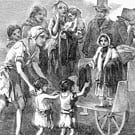
Civil War and the End of Slavery
In the early 1860s, the United States was in crisis. The Northern states and Southern states could not agree on the issue of slavery. Most people in the Northern states thought slavery was wrong. People in South, where the plantations depended on slavery, wanted to continue the practice. In 1861, the Civil War began between the North and South. It would be an extremely bloody war; over 600,000 people would die in the fighting. Many immigrants fought in the war. Since immigrants had settled mostly in the North, where factories provided jobs and small farms were available, hundreds of thousands of foreign-born men fought for the Union. In 1863, President Abraham Lincoln issued the Emancipation Proclamation, which declared that all the slaves in the rebelling Southern states were free. It was the beginning of the end of slavery.
To ensure that the abolishment of slavery was permanent, Congress passed the 13th Amendment to the Constitution, which outlawed slavery throughout the United States. The 14th Amendment, adopted in 1868, declared that African Americans were citizens of the United States. In 1870, African Americans numbered almost 5 million and made up 12.7 percent of the U.S. population.
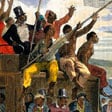
The Homestead Act
In the late 19th century, America was looking west. People began moving away from the now crowded Eastern cities. Some were motivated by the Homestead Act of 1862, which offered free land from the government. The government offered to give 160 acres of land—considered a good size for a single family to farm—in areas including Minnesota, Iowa, Kansas, and Nebraska. Homesteaders were required to stay on the land, build a home, and farm the land for five years. The offer attracted migrants from inside the country—and waves of more immigrants from Europe. For example, many people from Sweden, where land was extremely scarce, were drawn to come to the United States. These brave settlers worked hard to start a new life on the frontier. Though life was difficult, many succeeded.
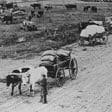
The Transcontinental Railroad
The Transcontinental Railroad was a massive construction project that linked the country by rail from east to west. The railway was built entirely by hand during a six-year period, with construction often continuing around the clock. Chinese and Irish immigrants were vital to the project. In 1868, Chinese immigrants made up about 80 percent of the workforce of the Central Pacific Railroad, one of the companies building the railway. The workers of the Union Pacific Railroad, another company that built the railroad, were mostly Irish immigrants. These railroad workers labored under dangerous conditions, often risking their lives. After the Transatlantic Railroad was completed, cities and towns sprung up all along its path, and immigrants moved to these new communities. The Transcontinental Railroad was a radical improvement in travel in the United States; after its completion, the trip from East Coast to West Coast, which once took months, could be made in five days.
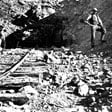
By 1880, America was booming. The image of America as a land of promise attracted people from all over the world. On the East Coast, Ellis Island welcomed new immigrants, largely from Europe. America was "the golden door," a metaphor for a prosperous society that welcomed immigrants. Asian immigrants, however, didn't have the same experience as European immigrants. They were the focus of one of the first major pieces of legislation on immigration. The Chinese Exclusion Act of 1882 severely restricted immigration from China.
And the 1907 "Gentlemen's Agreement" between Japan and the United States was an informal agreement that limited immigration from Japan. Despite those limitations, nearly 30 million immigrants arrived from around the world during this great wave of immigration, more than at any time before.
Ellis Island
In 1892, President Benjamin Harrison designated Ellis Island in New York Harbor as the nation's first immigration station. At the time, people traveled across the Atlantic Ocean by steamship to the bustling port of New York City. The trip took one to two weeks, much faster than in the past (when sailing ships were the mode of transportation), a fact that helped fuel the major wave of immigration. For many immigrants, one of their first sights in America was the welcoming beacon of the Statue of Liberty, which was dedicated in 1886. Immigrants were taken from their ships to be processed at Ellis Island before they could enter the country. About 12 million immigrants would pass through Ellis Island during the time of its operation, from 1892 to 1954. Many of them were from Southern and Eastern Europe. They included Russians, Italians, Slavs, Jews, Greeks, Poles, Serbs, and Turks. Explore the Ellis Island Interactive Tour
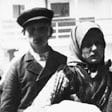
Bursting Cities
New immigrants flooded into cities. In places like New York and Chicago, groups of immigrants chose to live and work near others from their home countries. Whole neighborhoods or blocks could be populated with people from the same country. Small pockets of America would be nicknamed "Little Italy" or "Chinatown." Immigrants often lived in poor areas of the city. In New York, for example, whole families crowded into tiny apartments in tenement buildings on the Lower East Side of Manhattan. Many organizations were formed to try to help the new immigrants adjust to life in America. Settlement houses, such as Hull House in Chicago, and religious-based organizations worked to help the immigrants learn English and life skills, such as cooking and sewing.
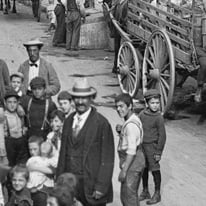
Angel Island
On the West Coast, Asian immigrants were processed at Angel Island, often called the "Ellis Island of the West." Angel Island, which lies off the coast of San Francisco, opened in 1910. Although the Chinese Exclusion Act of 1882 restricted immigration, 175,000 Chinese came through Angel Island over a period of three decades. They were overwhelmingly the main group processed here: In fact, 97 percent of the immigrants who passed through Angel Island were from China. Explore the Angel Island Activity
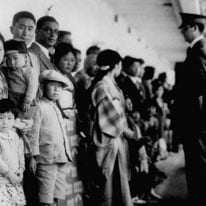
Building America
Many of the immigrants who arrived in the early 20th century were poor and hardworking. They took jobs paving streets, laying gas lines, digging subway tunnels, and building bridges and skyscrapers. They also got jobs in America's new factories, where conditions could be dangerous, making shoes, clothing, and glass products. Immigrants fueled the lumber industry in the Pacific Northwest, the mining industry in the West, and steel manufacturing in the Midwest. They went to the territory of Hawaii to work on sugar cane plantations. Eventually, they bargained for better wages and improved worker safety. They were on the road to becoming America's middle class.

By the 1920s, America had absorbed millions of new immigrants. The country had just fought in the "Great War", as World War I was known then. People became suspicious of foreigners' motivations. Some native-born Americans started to express their dislike of foreign-born people. They were fearful that immigrants would take the available jobs. Some Americans weren't used to interacting with people who spoke different languages, practiced a different religion, or were a different race. Racism, anti-Semitism, and xenophobia (fear and hatred of foreigners) were the unfortunate result. In 1924, Congress passed the National Origins Act. It placed restrictions and quotas on who could enter the country. The annual quotas limited immigration from any country to 3 percent of the number of people from that country who were living in the United States in 1890. The effect was to exclude Asians, Jews, blacks, and non-English speakers.
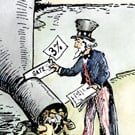
The Great Depression and War in Europe
In the 1930s, the country was going through the Great Depression, a terrible period of economic hardship. People were out of work, hungry, and extremely poor. Few immigrants came during this period; in fact, many people returned to their home countries. Half a million Mexicans left, for example, in what was known as the Mexican Repatriation. Unfortunately, many of those Mexicans were forced to leave by the U.S. government. In 1933, the Immigration and Naturalization Service (INS) was formed. It still exists today. In 1938, World War II started in Europe. America was again concerned about protecting itself. Fears about foreign-born people continued to grow. As a result of the turmoil in the 1930s, immigration figures dropped dramatically from where they had been in previous decades. In the 1920s, approximately 4,300,000 immigrants came to the United States; in the 1930s, fewer than 700,000 arrived.

World War II and the Postwar Period
The United States entered World War II in 1942. During the war, immigration decreased. There was fighting in Europe, transportation was interrupted, and the American consulates weren't open. Fewer than 10 percent of the immigration quotas from Europe were used from 1942 to 1945. In many ways, the country was still fearful of the influence of foreign-born people. The United States was fighting Germany, Italy, and Japan (also known as the Axis Powers), and the U.S. government decided it would detain certain resident aliens of those countries. (Resident aliens are people who are living permanently in the United States but are not citizens.) Oftentimes, there was no reason for these people to be detained, other than fear and racism. Beginning in 1942, the government even detained American citizens who were ethnically Japanese. The government did this despite the 14th Amendment of the Constitution, which says "nor shall any State deprive any person of life, liberty or property without the due process of law."
Also because of the war, the Chinese Exclusion Act was repealed in 1943. China had quickly become an important ally of the United States against Japan; therefore, the U.S. government did away with the offensive law. Chinese immigrants could once again legally enter the country, although they did so only in small numbers for the next couple of decades. After World War II, the economy began to improve in the United States. Many people wanted to leave war-torn Europe and come to America. President Harry S. Truman urged the government to help the "appalling dislocation" of hundreds of thousands of Europeans. In 1945, Truman said, "everything possible should be done at once to facilitate the entrance of some of these displaced persons and refugees into the United States. " On January 7, 1948, Truman urged Congress to "pass suitable legislation at once so that this Nation may do its share in caring for homeless and suffering refugees of all faiths.
I believe that the admission of these persons will add to the strength and energy of the Nation." Congress passed the Displaced Persons Act of 1948. It allowed for refugees to come to the United States who otherwise wouldn't have been allowed to enter under existing immigration law. The Act marked the beginning of a period of refugee immigration.
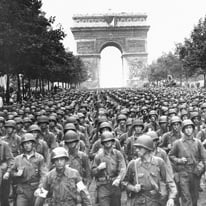
The Cold War Begins
In 1953, the Refugee Relief Act was passed to replace the Displaced Persons Act of 1948, which had expired. It also allowed non-Europeans to come to the United States as refugees. The Refugee Relief Act also reflected the U.S. government's concern with Communism, a political ideology that was gaining popularity in the world, particularly in the Soviet Union. The Soviet Union was also controlling the governments of other countries. The Act allowed people fleeing from those countries to enter the United States. When he signed the Act, President Dwight D. Eisenhower said, "This action demonstrates again America's traditional concern for the homeless, the persecuted, and the less fortunate of other lands. It is a dramatic contrast to the tragic events taking place in East Germany and in other captive nations." By "captive nations," Eisenhower meant countries being dominated by the Soviet Union.
In 1956, there was a revolution in Hungary in which the people protested the Soviet-controlled government. Many people fled the country during the short revolution. They were known as "fifty-sixers". About 36,000 Hungarians came to the United States during this time. Some of their countrymen also moved to Canada. In 1959, Cuba experienced a revolution, and Fidel Castro took over the government. His dictatorship aligned itself with the Soviet Union. More than 200,000 Cubans left their country in the years after the revolution; many of them settled in Florida.
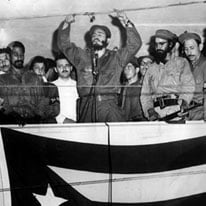
Immigration and Naturalization Act of 1965
In 1965, President Lyndon B. Johnson signed the 1965 Immigration and Naturalization Act, also known as the Hart-Celler Act. This act repealed the quota system based on national origins that had been in place since 1921. This was the most significant change to immigration policy in decades. Instead of quotas, immigration policy was now based on a preference for reuniting families and bringing highly skilled workers to the United States. This was a change because in the past, many immigrants were less skilled and less educated than the average American worker. In the modern period, many immigrants would be doctors, scientists, and high-tech workers. Because Europe was recovering from the war, fewer Europeans were deciding to move to America. But people from the rest of world were eager to move here. Asians and Latin Americans, in particular, were significant groups in the new wave of immigration. Within five years after the act was signed, for example, Asian immigration had doubled.
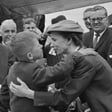
Vietnamese Immigration and the Refugee Act
During the 1960s and 1970s, America was involved in a war in Vietnam. Vietnam is located in Southeast Asia, on the Indochina peninsula. From the 1950s into the 1970s there was a great deal of conflict in the area. After the war, Vietnamese refugees started coming to the United States. During the 1970s, about 120,000 Vietnamese came, and hundreds of thousands more continued to arrive during the next two decades. In 1980, the government passed the Refugee Act, a law that was meant specifically to help refugees who needed to come to the country. Refugees come because they fear persecution due to their race, religion, political beliefs, or other reasons. The United States and other countries signed treaties, or legal agreements, that said they should help refugees. The Refugee Act protected this type of immigrant's right to come to America.

Latin American Immigration
During the 1980s, waves of immigrants arrived from Central America, the Caribbean, and South America. Hundreds of thousands of people came just from Cuba, fleeing the oppressive dictatorship of Fidel Castro. This was a significant new wave of immigrants: During the 1980s, 8 million immigrants came from Latin America, a number nearly equal to the total figure of European immigrants who came to the United States from 1900 to 1910, when European immigration was at a high point. The new immigrants changed the makeup of America: By 1990, Latinos in the United States were about 11.2 percent of the total population.

A Multicultural America
Since 1990, immigration has been increasing. It is at its highest point in America's history. In both the 1990s and 2000s, around 10 million new immigrants came to the United States. The previous record was from 1900 to 1910, when around 8 million immigrants arrived. In 2000, the foreign-born population of the United States was 28.4 million people. Also in that year, California became the first state in which no one ethnic group made up a majority. Today, more than 80 percent of immigrants in the United States are Latin American or Asian. By comparison, as recently as the 1950s, two-thirds of all immigrants to the United States came from Europe or Canada.
The main countries of origin for immigrants today are Mexico, the Philippines, China, Cuba, and India. About 1 in 10 residents of the United States is foreign-born. Today, the United States is a truly multicultural society.

- Explore Ellis Island
- Meet Young Immigrants
- Immigration Data
- Virtual Field Trip To Ellis Island
Interactive Tour of Ellis Island

The Passage
The long, difficult journey to America begins.
The Arrival
The Statue of Liberty greets tired travelers.
The Baggage Room
Passengers check their precious possessions.
The immigration process begins.
The Registry Room
People await inspection in long winding lines.
The Medical Exam
Chalk marks identify those who are ill.
The Legal Inspection
Each person must answer 29 questions—with no mistakes.
For some, Ellis Island was the "Isle of Tears".
The Stairs of Separation
Immigrants file out based on their final destinations.
The Kissing Post
Families are reunited at the end of the long journey.
Welcome to Ellis Island! More than 12 million immigrants made their first stop in America at the Ellis Island Immigration Station between 1892 and 1954. In fact, more than 40 percent of Americans can trace their family history back to Ellis Island.
Follow in the immigrants' footsteps by taking this tour. You'll hear first-hand stories told by people who came through Ellis Island; see historical photographs and films; read fascinating facts; and discover the central role this station played in the story of American immigration. Learn More about Ellis Island
Did You Know
- Ellis Island is a small island in New York Harbor, near Manhattan. The federal government owns the island.
- The largest building on Ellis Island, made of red brick, opened in 1900 and became a famous symbol of American immigration.
- In 1890, President Benjamin Harrison established the nation's first immigration station on Ellis Island.
- The Immigration Station closed in 1954. Ellis Island became a museum in 1965 and is now a part of the U.S. National Park Service.
The Ellis Island Museum Is Revitalizing the Story of American Immigration
A $100 million renovation will help preserve the history of the millions of immigrants who passed through the island in the late 19th and early 20th centuries
/https://tf-cmsv2-smithsonianmag-media.s3.amazonaws.com/accounts/headshot/SarahKuta.png)
Daily Correspondent
:focal(2600x1758:2601x1759)/https://tf-cmsv2-smithsonianmag-media.s3.amazonaws.com/filer_public/fb/99/fb99cb7d-292a-4f7f-8b83-1b3f1c01e0b3/ellis_entrance_-_courtesy_paul_seibert_-_statue_of_liberty-ellis_island_foundation.jpg)
Between 1892 and 1954, more than 12 million immigrants passed through Ellis Island hoping to start a new life in America. Situated between New York and New Jersey, the historic site was often the first piece of dry land weary travelers touched after a long journey across the Atlantic.
Since 1990, the site has been home to the Ellis Island National Museum of Immigration . Now, after more than three decades, the museum is getting a makeover.
The $100 million project, which was announced late last month, includes the creation of new public spaces, the expansion of the American Immigrant Wall of Honor and the development of new interactive experiences. When work is complete, the museum will have touchscreens, immersive films, soundscapes and other pieces of media.
The museum will also offer self-guided tours in 12 languages, as well as American Sign Language tours and descriptive audio tours for visitors who are blind or visually impaired.
/https://tf-cmsv2-smithsonianmag-media.s3.amazonaws.com/filer_public/9b/d9/9bd91ab1-6fc3-49ec-9724-70d95dfe6963/records_discovery_center_north_rendering_-_courtesy_of_statue_of_liberty-ellis_island_foundation.jpg)
The historic structure will feature an expanded family history center, where guests can look up their relatives . Crews will add new exhibition space, a miniature theater and public research stations.
The museum is also expanding its arrival records database by adding nearly 90 million records from other ports of entry nationwide, including New Orleans and San Francisco, reports CNN ’s Catherine E. Shoichet. When finished, the database will include 154 million searchable documents.
At its peak, Ellis Island processed around 5,000 immigrants per day. So many people passed through that an estimated 40 percent of individuals living in the United States today are related to someone who arrived via the island, per the National Park Service .
Searching for those ancestors is “kind of the emotional core of a visit to the island,” says Jesse Brackenbury, president and CEO of the Statue of Liberty-Ellis Island Foundation , which runs the museum in partnership with the National Park Service, to CNN.
“You get off the ferry in the exact same place where 12 million people got off the ferry, and you walk into the baggage room, and you follow in their footsteps … in a place where the walls are just vibrating with history,” he adds.
The building will also get some structural upgrades, including renovated restrooms, Wi-Fi networks and HVAC and electrical systems. Crews will install additional seating, better signage and a 120-foot-wide video screen. For guests who don’t have time to explore all of the museum’s 137,000 square feet, a new gallery near the entrance will provide an overview of the museum’s themes.
“Visitors who come are often a little tired by the time they get there,” Brackenbury tells the New York Times ’ James Barron. “You’ve waited for the ferry and taken the ferry, and it’s been a long day already.”
Crews will complete the interior work in phases so that the museum can remain open for the duration of the project, which is slated to finish in 2026. The foundation has raised roughly 60 percent of the funding needed for the renovation and is seeking donations to cover the rest of the costs.
/https://tf-cmsv2-smithsonianmag-media.s3.amazonaws.com/filer_public/f4/48/f448332e-428e-46ec-ab1e-393e89babe31/immersive_experiences_-_courtesy_of_statue_of_liberty-ellis_island_foundation.jpg)
Separately, the National Park Service is launching a $17.7 million project to give the Beaux-Arts building’s exterior a facelift. Crews will replace the windows and re-point the facade to help prevent water infiltration and improve the building’s thermal efficiency.
Ellis Island became the nation’s primary federal immigration station when it opened on January 1, 1892. After World War I, the U.S. imposed strict immigration quotas , which decreased the number of people coming into the county. For immigrants who did make it through, new laws allowed them to visit an American embassy or consulate in their home country before continuing on to the U.S., replacing Ellis Island’s inspection process. At that point, it became a detention facility for “enemy aliens, those immigrants over-staying their leave, any potentially undesirable immigrants and those with questionable cases,” according to the National Park Service .
The island officially closed in 1954, and its buildings and infrastructure gradually began to show their age. In 1965, President Lyndon Johnson made Ellis Island part of the Statue of Liberty National Monument, placing it under the jurisdiction of the National Park Service.
Nearly two decades later, in the 1980s, President Ronald Reagan asked automaker executive Lee Iacocca to raise private funds to restore Ellis Island and the Statue of Liberty, which led to the creation of the foundation.
“We are a nation of immigrants, and Ellis Island is the symbol of that history,” says Brackenbury in the foundation’s statement. “Our project will ensure that the National Museum of Immigration will welcome, educate and inspire visitors for decades to come.”
Get the latest stories in your inbox every weekday.
/https://tf-cmsv2-smithsonianmag-media.s3.amazonaws.com/accounts/headshot/SarahKuta.png)
Sarah Kuta | READ MORE
Sarah Kuta is a writer and editor based in Longmont, Colorado. She covers history, science, travel, food and beverage, sustainability, economics and other topics.

The best free things to do in New York
N ew York City is not cheap. That’s a well-known fact. It’s even more expensive these days, thanks to post-pandemic inflation. But don’t let that stop you form enjoying this metropolis of nearly nine million denizens. That said, there are a legion of fun, free things to do too. Here are the best free things to do for solo travelers, children, couples, and families, from free ferry trips to Staten Island (where views over Manhattan are glorious), and wandering through Central Park, to watching the street artists at Washington Square, and soaking up the atmosphere at South Street Seaport.
Below our expert shares his pick of the best things to do for free in New York . For more inspiration, see our guides to the city's best hotels , restaurants , nightlife , bars , shopping and attractions , plus how to spend a weekend in New York .
Ellis Island
Search for a lost ancestor at ellis island.
For more than 60 years from 1892, Ellis Island served as one of the main immigration processing centres in the United States. It's estimated that 40 per cent of living Americans today can trace at least one ancestor whose gateway to America was through this island just off the coast of Manhattan, many escaping war and famine. Today the place is a fascinating monument to human immigration. Visit the restored Main Arrivals Hall and the museum which is a self-guided tour through the complex's history. At the American Family Immigration History Center, visitors can do multimedia searches through the archives. Who knows? You might just find a lost ancestor.
Website: ellisisland.org
Nearest metro: Ferry terminal from Battery Park
Governors Island
Explore a lesser known corner of new york city.
This 172-acre island south of the Brooklyn Bridge off the southern tip of Manhattan is one of the city's most beloved green spaces. Between May and October, you can access it by ferry from the Battery Maritime Building (10 South Street) in Manhattan or from Brooklyn Bridge Park in DUMBO. With bikes for hire, a beach, acres of lawns, and a promenade around the perimetre, it's perfect for a stroll, or an afternoon picnic taking in views of Manhattan, Brooklyn and the Statue of Liberty. There are a number of food trucks and vendors operating on the island, and a line-up of summer-long events from the Jazz Age Lawn Party to pop-up dinners.
Website: govisland.org
Nearest metro: Ferry from Battery Maritime Building
Financial District
Visit the 9/11 memorial monument.
There are few places in New York City as emotionally, politically and patriotically loaded as this spot in lower Manhattan. The memorial consists of the footprints of the two towers, today, two giant reflecting pools with the names of the victims inscribed along the periphery. Another powerful monument to the victims who lost their lives on 11 September, 2001 is inside St. Paul's Chapel, the diminutive church from 1766 across the street from the reflecting pools, houses photos, fliers, and mementos related to the attacks. Fans of contemporary architecture should take a look at the new Santiago Calatrava-designed subway station that looks like the skeleton of a stegosaurus.
Website: 911memorial.org
Nearest metro: World Trade Center; Chambers St; Wall St; Fulton St
Take it to the bridge… the Brooklyn Bridge
Arguably the most famous bridge in the world, the Brooklyn Bridge is not only aesthetically pleasing, it makes for a great walk. The 271-foot-tall neo-gothic arches are certainly the bridge's trademark, but strolling along the elevated pedestrian walkway (starting in Brooklyn and walking toward Manhattan) is a must for any visitor. When it was completed in 1883, it not only united the two, it was the longest suspension bridge in the world at almost 7,000 feet. The bridge's construction was overseen first by John Augustus Roebling and then his son, Washington. But after Washington suddenly died, his wife, Emily Warren Roebling, took over and finished the job, a fact that has been largely lost to history.
Nearest metro: Brooklyn Bridge-City Hall (Manhattan); York St, High St (Brooklyn)
South Street Seaport
Explore an historic port.
Most New Yorkers have known the 400-year-old South Street Seaport as the home of the massive fish market. It moved to the Bronx in 2005 and now locals and visitors flock here to meander the cobblestoned streets flanked by the largest concentration of 19th-century buildings in New York. Big efforts have gone into reviving the neighbourhood, whose roots can be traced back to the 17th century, with the development of wide spaces, social dining and drinking scene, shops and a market. It's entertaining enough to stroll the streets, window shopping, checking out the historic ships docked on the East River, and taking in the views of the nearby Brooklyn Bridge.
Nearest metro: Wall St
Little Italy
Sip an espresso in little italy.
Benvenuto al'Italia Piccola. Also known as Little Italy, this swathe of all things Italian isn't what it used to be. For decades the area has been losing its Italianness to encroaching Chinatown. But that hasn't stopped the masses of tourists from descending upon what's left, Mulberry Street. Little Italy today is a collection of shops peddling in Italian food products and mediocre restaurants (complete with aggressive barkers trying to lure every passerby inside). Nurse a cappuccino at an outdoor café if you must, but don't waste time and money eating at any of these restaurants. Still, Little Italy is an amusing quick diversion on your way to Chinatown or elsewhere.
Nearest metro: Canal St
Head to the markets of Chinatown
Sprawling and dense at the same time, New York's Chinatown isn't just the chief neighbourhood in which to pick up super cheap 'I Love NY' t-shirts and gadgets. Chinese began settling in the area in the 1850s and it has grown and expanded since. It's not the biggest Chinatown outside of the motherland – that distinction would go to the Chinese-area in Ho Chi Minh City, Vietnam – but estimates suggest there are about 100,000 Chinese living in this Manhattan enclave. There aren't many Chinese landmarks here, so put away the map and wander the streets where markets brim with live seafood and restaurants buzz with atmosphere.
Lower East Side
Feel like a movie star as you explore lower east side.
Sometimes this neighbourhood feels like a movie set, with five-floor tenement buildings, their façades partly masked by snaking fire escapes; narrow streets; and subterranean shops. It all makes for one of the city's most atmospheric neighbourhoods. A century ago, the Lower East Side was a bastion of new immigrants – mostly Central and Eastern European – and due to high crime rates it became known as the place not to go (lest you wanted to leave without your wallet). Today, though, the Lower East Side has become synonymous with one thing: partying. Its streets are overflowing with bars but there are also some great restaurants. And don't miss the very intriguing Tenement Museum.
Nearest metro: Delancey St
Greenwich Village
Live like the locals in greenwich village.
Say you live in 'the Village' and locals who know their New York neighbourhoods will swoon. This leafy area, filled with historic brownstones, stretches from Fifth Avenue to the Hudson River, W. 14th to Houston Streets. There are actually two neighbourhoods that make up the Village. The names 'Greenwich Village' and 'West Village' are generally interchangeable, but locals use West Village to demarcate the more tranquil section between Sixth Avenue and the Hudson River, while Greenwich Village is generally referred to as the area centred around Washington Square and the intersection of Bleecker and MacDougal Streets. The latter area might interest fans of the 1960s, as it was here where young, struggling artists named Bob Dylan and Jimi Hendrix, among others, got their start.
Nearest metro: W. 4th St
Enjoy the street performers at Washington Square
It might be hard to envision it today, but this well-manicured swath of land in the centre of downtown Manhattan was once murky marshland, a cemetery, and then a military parade ground. Of the city's 1,900 or so parks, Washington Square is one of the most memorable. Not only because of the giant arch that stands where Fifth Avenue begins; nor for the recently revamped and re-manicured landscape of the place, but because of the people who frequent the park. Bohemians and beatniks, street performers and students from nearby New York University give the place a groovy and fun vibe. On hot days, children play in the fountain and jazz musicians thump out tunes.
Nearest metro: W. 4th St
Meatpacking District
Admire the high line park's glorious gardens.
It all began with a long stretch of abandoned elevated railroad track. Built in the 1930s, the track was used to transport cargo from the piers along the Westside at 34th Street to downtown Manhattan until 1980. But the track fell into disarray and a movement to turn it into a park picked up steam, aided by the support of celebrities. And finally in June 2009, the High Line Park officially opened, becoming only the second elevated park in the world (after Promenade Plantée in Paris). Since opening, the High Line has become an instant Big Apple classic site, wowing visitors and locals with its cool design (it goes right under the Standard Hotel) and incorporating much of the natural surrounding.
Nearest metro: W. 14th St./Eighth Ae
Explore a ‘Little Island’ in the middle of the Hudson River
While it was being built in 2020, many passersby stopped to marvel at this odd structure in the Hudson River with its massive stone tulip-shaped columns emerging from the water to support a lush landscape of verdant, path-carved hills. Little Island put down its drawbridge to Manhattan in May 2021 and it’s been a hit ever since. Funded mostly by a foundation run by businessman Barry Diller and his fashion designer wife Diane von Furstenberg and designed by London-based Thomas Heatherwick, the one-hectare artificial island boasts food kiosks and an amphitheatre where regular free concerts take place in the warm-weather months. Spend an hour or so traversing the trails and taking in the splendid views of Manhattan.
Nearest metro: W. 14th St./Eighth Ave
Flatiron and NoMad
Take a walking tour of the flatiron district.
Every Sunday at 11am, rain or sunshine, a professional tour guide is waiting at the Flatiron Building on 23rd Street and Fifth Avenue, in order to give a walking tour of the Flatiron District and the NoMad neighborhood . And it’s entirely free. The 90-minute stroll takes you past some of the neighborhoods’ most iconic landmarks while the guide puts everything into a historical context.
Website: flatironnomad.nyc/things-to-do/free-tours
Nearest metro: 23rd St
Midtown West
Pull up a chair at times square.
This 'square' (which is really just the convergence of Seventh Avenue and Broadway) flashes and pops with enough lights to make your head spin. But the square wasn't always so bright. After the Depression, the area was the most dangerous part of town. And in the 1980s, the strip clubs and peeps show houses became infamous. All that's gone now in the new Disney-fied version of the space, where mega-stores compete with fast-moving news tickers and flickering billboards for your attention. The latest development, though, is a good one: tables and chairs have replaced part of the street, making Times Square a much more comfortable place to spend a couple hours.
Nearest metro: Times Square
Look studious at the New York Public Library
Perhaps one of the most iconic libraries in the world—its two stone lions acting as sentries that bookend the steps leading up to the entrance—the main branch of the New York Public Library is a fun (and free) place to wander around. Head up to the famed first-floor Main Reading Room and marvel at a two-block-long space, 52-foot-high ceilings, bathed in natural light, where scholars and the intellectually curious comb over documents from the cellar archive where over four million books are stored.
Website: nypl.org
Nearest metro: 42nd St./Bryant Park
Midtown East
Marvel at grand central station's architectural elegance.
What is this, Grand Central Station? We've all asked this question when we're in a suddenly and unexpectedly busy place. Now go see where it originated and you'll catch the true meaning of this bustling transportation hub, as a whopping 750,000 people pass through the station every day. Yes, you say, it's only a train station. But quite a majestic one indeed. Roman-style vaults may impress, but visitors are awed by the starry sky of an arched ceiling in the main ticket hall. Built in 1913, Grand Central is the dream of Cornelius Vanderbilt. Unlike once-glorious, now decrepit Penn Station, Grand Central is still shining like the day Vanderbilt conceived it.
Website: grandcentralterminal.com
Nearest metro: Grand Central/42nd St
Take a closer look at the Chrysler Building
The 86-storey Empire State Building may get all the oohs and aahs from out-of-towners, but the 'little' Chrysler building (at 77 floors) is a stunner. Look closely enough and you'll notice the grills of automobiles at the top (the name of the building should be a clue as to why it's car themed). But there are more than just car parts going on here: gargoyles jut out at floor 59 and eagles two floors above that. Made with stainless steel, this striking skyscraper gleams in the sunlight during the day and reflects the city lights at night. Most of the exterior of the building is off limits, but pop into the lobby, open to the public during the day, to get a taste of the marble-clad Art Deco interiors.
Nearest metro: Grand Central/42nd St
Visit St. Patrick's Cathedral
It's not New York's biggest cathedral (that honour would go to St. John the Divine), but St. Patrick's is the city's most famous and arguably most beautiful. This bewitching neo-gothic structure makes for a nice architectural contrast with the Art Deco-clad Rockefeller Center across the street. Completed in 1878, the cathedral is one of the country's most identifiable churches. Up to 2,200 people can fit inside and the interior has been packed to take part in requiem masses for notables such as Babe Ruth, Celia Cruz, Robert F. Kennedy, Joe DiMaggio, and Andy Warhol. Be sure to check out the Pieta, three times larger than Michelangelo's version in the Vatican, and sculpted by Araldo Perugi.
Website: saintpatrickscathedral.org
Nearest metro: 5th Ave./53rd St
Central Park
Explore central park and enjoy its many elements.
Central Park is the work of genius landscape architect Frederick Law Olmsted (who also helped create Prospect Park in Brooklyn and Golden Gate Park in San Francisco). Olmsted's objective was to give city dwellers a reprieve from the blights of urban life, to make them forget – if only for a couple hours – that they were in one of the most bustling cities on the planet. It worked. Even today, one finds New Yorkers and New York visitors taking advantage of the park's many elements: from ponds and orchards to rock formations and meadows. A whopping 25 million people visit the park each year and it still does a fine job of absorbing urban dwellers.
Website: centralparknyc.org
Nearest metro: 59th St./Columbus Circle
Upper West Side
Take a stroll around columbia university.
Sedate and tranquil compared to the rest of Manhattan, the Upper West Side is for many a reprieve from the hustle and bustle of Midtown or lower Manhattan. Largely residential with quiet tree-lined streets, the neighbourhood has a few attractions that may inspire a visit: the American Museum of Natural History, for example. Fans of Seinfeld should most certainly wander up: the coffee shop on the corner of Broadway and W. 112th St. may look very familiar, but Columbia University is a lovely stroll, as it exudes a classic university campus with its monumental neo-classical buildings, sculpture-studded plazas, and students buzzing around.
Website: columbia.edu
Nearest metro: 116th St./Columbia University
Washington Heights
View spanish art at the hispanic society museum.
Hop on the A or C subway trains to 155th Street to the Hispanic Society Museum , a free museum that owns the the largest collection of Spanish art and manuscripts outside of Spain. The collection includes religious artifacts, furniture, textiles, ceramics and art by some of Spain’s most famous artists, including Velazquez, El Greco, Goya, and Joaquin Sorolla, whose monumental 14-panel painting called “Visions of Spain” is worth the trip to the museum in and of itself.
Website: hispanicsociety.org
Nearest metro: 155th St
Watch fireworks at Coney Island
It's one of the longer journeys you'll take on the subway – about an hour – but it's a pleasant one, as part of the way is elevated. Coney Island has long been a summer escape for urbanites. Stroll the historic boardwalk, take a dip in the Atlantic, or take in a baseball game, as the Brooklyn Cyclones minor league baseball team play at the charming MCU Park just off the Boardwalk with free fireworks every Friday night through summer. If you're there for lunch, Nathan's Famous on Surf Avenue is, indeed, world famous, hosting their Fourth of July Hot Dog Eating Contest since 1916, but for a better calibre of food try Totonno's (1524 Neptune Ave) offering some of New York's finest pizza.
Website: coneyisland.com
Nearest metro: Coney Island/Stillwell Ave
Take a peaceful walk through Green Wood Cemetery
When it was founded in 1838, this vast and bewitching cemetery was actually a rural spot in Brooklyn. Today it sits smack in the centre of an urban landscape. And provides for an enchanting, peaceful stroll. The 478-acre city of the dead is actually the highest elevation in the borough, making for some lovely views, as you stroll along ornate gravestones and neo-Gothic chapels. In the 19th century before Prospect Park was constructed, Green Wood was Brooklyn's unofficial city park. If you’re looking for the graves of famous people, seek out the burial spots for conductor/composer Leonard Bernstein and artist Jean-Michel Basquiat.
Website: green-wood.com
Nearest metro: 25th St
Staten Island
Board the staten island ferry for great views of manhattan.
Sad as it is to say, there are few obvious sightseeing opportunities in the borough of Staten Island. One of them, though, is to take the free ferry from Manhattan. It provides a great view of the lower Manhattan skyline and the Statue of Liberty. And the Staten Island neighbourhood at the ferry dock, St. George, boasts cafés and restaurants. Over 70,000 people per day take the five-mile, 25-minute scenic ferry ride. You should too. Ferries leave every 30 minutes.
Website: siferry.com
Nearest metro: Whitehall St./South Ferry
How we choose
Every attraction and activity in this curated list has been tried and tested by our destination expert, to provide you with their insider perspective. We cover a range of budgets and styles, from world-class museums to family-friendly theme parks – to best suit every type of traveller. We update this list regularly to keep up with the latest openings and provide up to date recommendations.
Sign up to the Front Page newsletter for free: Your essential guide to the day's agenda from The Telegraph - direct to your inbox seven days a week.
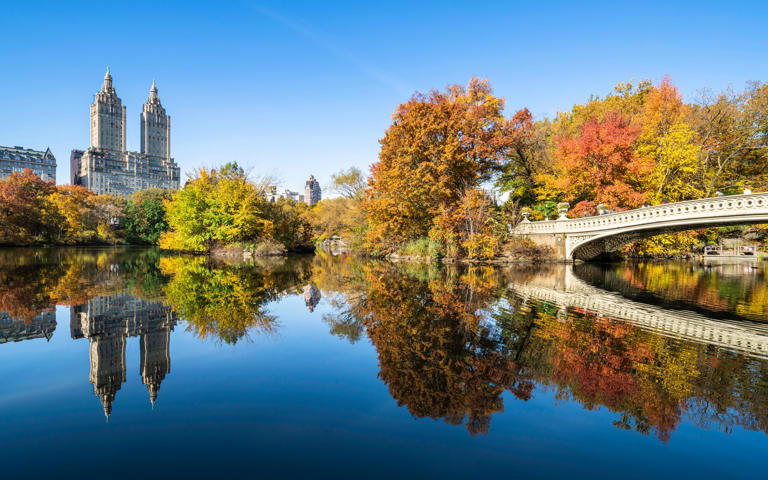
Normandy High School students enjoy tuneful and bueno trip to New York City: Sun Postings
- Published: Apr. 22, 2024, 7:40 a.m.

Normandy High School choir and Spanish students recently visited New York City. (Courtesy of Parma City Schools) Courtesy of Parma City Schools
- John Benson, special to cleveland.com
PARMA, Ohio -- Over Parma City School District’s spring break, the Normandy choir and Spanish students participated in a joint trip to New York City.
Students performed for onlookers at St. John the Divine and engaged in impromptu performances in Central Park.
They also participated in a Broadway Classroom learning experience and attended two Broadway theatrical performances.
Students enjoyed a guided tour of the city, visited Ellis Island and the Statue of Liberty, as well as toured the 9/11 Memorial and Museum.
Other highlights included trying new foods at Havana Central in Times Square and a particularly exciting dinner that included musical performances in Little Italy.
Cuyahoga County Public Library Parma Heights branch. (John Benson/cleveland.com) John Benson/cleveland.com
Spring planting season: Parma Heights Recreation and the Parma Heights branch of the Cuyahoga County Public Library are once again sponsoring a seed library.
Residents are encouraged to grow their own crops after selecting seeds from the Pearl Road library branch.

State Rep. Sean Brennan last month gave St. Charles Borromeo School fourth-graders a tour of the Statehouse. (Courtesy of Sean Brennan) Courtesy of Sean Brennan
Statehouse visit: State Rep. Sean Brennan was visited last month by St. Charles Borromeo School fourth-graders taking a field trip to Columbus.
Brennan gladly gave the students a tour of the Ohio Statehouse.
Information, please: Readers are invited to share information about themselves, their families and friends, organizations, church events, etc. in Brooklyn, Independence, Parma, Parma Heights and Seven Hills for the Sun Postings column, which I write on a freelance basis. Awards, honors, milestone birthdays or anniversaries and other items are welcome. Submit information at least 10 days before the requested publication date to [email protected].
Read more news from the Parma Sun Post here.
If you purchase a product or register for an account through a link on our site, we may receive compensation. By using this site, you consent to our User Agreement and agree that your clicks, interactions, and personal information may be collected, recorded, and/or stored by us and social media and other third-party partners in accordance with our Privacy Policy.
- Skip to global NPS navigation
- Skip to this park navigation
- Skip to the main content
- Skip to this park information section
- Skip to the footer section

Exiting nps.gov
Alerts in effect, virtual tour.
Last updated: April 22, 2020
Park footer
Contact info, mailing address:.
Receiving Office 1 Ellis Island Jersey City, NJ 07305
212 363-3200
Stay Connected

COMMENTS
To purchase tickets in advance, Go to StatueCityCruises.com or call 1-877-523-9849 (877-LADY-TIX). Tickets can be purchased in person at the Statue City Cruises ticket booths located in Castle Clinton in Battery Park (NYC) or at the ferry departure point in Liberty State Park in New Jersey. Ferry schedules change seasonally and during periods ...
The comprehensive option gives you a guided tour that covers both Liberty and Ellis Island. Quicker options offer a guide for Liberty only or an audioguide for both islands. Avoid ticketing hassles: round-tip ferry tickets and museum admission are included. Begin your tour at historic Castle Clinton in Battery Park.
133. Experience three of New York City's iconic sights with this tour of the Statue of Liberty, Ellis Island, and the 9/11 Memorial. Start by boarding a ferry to Lady Liberty; head to Ellis Island to learn about the immigrant experience; then, return to Lower Manhattan to visit the 9/11 Memorial.
Planning Ahead For Your Visit. Visiting Liberty Island is one of the most rewarding experiences of any trip to New York City. However, visitors who wish to enter the pedestal and visit the crown must secure reservations through Statue City Cruises, the ONLY AUTHORIZED ticket seller for Statue of Liberty National Monument and Ellis Island. The National Park Service has implemented a reservation ...
Ellis Island's Great Hall once had lines of immigrants speaking several different languages as they awaited processing. In 1986, it was carefully restored to look as it did a century ago. NPS Photo. More than 12 million immigrants entered the United States through Ellis Island, the nation's chief gateway during the years 1892 to 1924.
Explore the Statue of Liberty and Ellis Island with a guided tour. Get travel tips, learn about our award-winning Statue of Liberty tour, and more! ... A must see when in New York. Great experience going from Liberty Island to Ellis island. Our guide was super nice, very knowledgeable. ... Top Rated Tours; Local New Yorkers;
Statue of Liberty Tour with Ellis Island & Museum of Immigration. 174. Day Cruises. from. $59.00. per adult (price varies by group size) LIKELY TO SELL OUT*. Secrets of the Statue of Liberty and Ellis Island Guided Tour. 84.
Come see why with this four-hour, expert-led tour of Liberty and Ellis islands. Get special access tickets to board the ferry, and enjoy the ride over as your New York guide entertains you with surprising true stories about the statue. On the islands, your guide will take you on a walking tour to share more about each of these places and their ...
Ellis Island: The Complete Visitors Guide. Everything You Need to Plan Your Visit to Ellis Island. Between 1892 and 1954 over 12 million immigrants arrived in New York City by steamship. Their first stop was Ellis Island where they underwent legal and medical examinations before being cleared for entry to the United States.
If you answered "Whatever it takes," you echo the feelings of the 12 million immigrants who passed through these now quiet halls from 1892 to 1954. Ellis Island afforded them the opportunity to attain the American dream for themselves and their descendants. Come hear their stories.
About Us. Statue of Liberty boat specialized in sightseeing tours to the Statue of Liberty and Ellis Island plus ground zero and the 911 memorial pools and ground zero. Operating guided tours of New York City. Sightseeing cruises for 60 minutes and 90 minutes departing from Pier 36 located at 299 South Street directly under the Manhattan Bridge ...
Ellis Island is named for Manhattan merchant Samuel Ellis who was the original owner in the 1770s. The island was owned by the state of New York until 1808 when it was sold to the federal government for immigration purposes. During its 62 years of operation, Ellis Island welcomed more than 12 million immigrants into the United States.
Take a journey of a lifetime on a private tour to the iconic Statue of Liberty. Explore the island and the stories that shine light on her grace and symbolism. Then continue on to Ellis Island and for an immersive exploration of the gateway to freedom, opportunity and the American dream. Capture amazing photos throughout your inspiring journey of this New York City unforgettable experience.
Beat the crowds with an early departure time on a half-day tour to four of New York's top landmarks. In addition to navigating for you, your guide provides little-known facts and stories about the 9/11 Memorial, Battery Park, Ellis Island, and the Statue of Liberty. All admission tickets and entrance fees are included in the tour, eliminating the hassle of buying them separately on your own.
Ellis Island: Our most recommended tours and activities. 1. New York City: Statue of Liberty & Ellis Island with Ferry. Hop on board the ferry and enjoy a self-guided tour of the Statue of Liberty and Ellis Island from New Jersey. Visit Liberty Island, explore the Ellis Island Immigration Museum, and learn fascinating facts as you go.
17 Battery Place #324 New York, NY 10004-3507 (212) 561-4588 [email protected] Dedicated to the Restoration and Preservation of the Statue of Liberty and Ellis Island.
Hard Hat tour worth it, but plan ahead. Review of Ellis Island. Reviewed October 29, 2023. I was with my 76 year old mother and 14 year old son so I wanted to be sure we had a pleasant experience and were not waiting in line like cattle for too long. We booked the Pedestal and Ellis Island hard hat tour for a Monday morning (the first hard hat ...
Learn about Ellis' history on a ranger-lead tour. NPS photo. FREE Ranger-Guided Tours: Both National Park Service Rangers and dedicated Volunteers-in-Park lead walking tours throughout the museum. Tours are approximately 40 minutes in length, and chronicle island history during the busiest years of immigration of 1892 and 1924.
Ellis Island, a historical site in New York City, opened in 1892 as an immigration station and processed more than 12 million immigrants until it closed in 1954.
Ellis Island is a small island in New York Harbor, near Manhattan. The federal government owns the island. The largest building on Ellis Island, made of red brick, opened in 1900 and became a famous symbol of American immigration. In 1890, President Benjamin Harrison established the nation's first immigration station on Ellis Island.
Between 1892 and 1954, more than 12 million immigrants passed through Ellis Island hoping to start a new life in America. Situated between New York and New Jersey, the historic site was often the ...
Ellis Island Virtual Tour. Ellis Island Part of Statue of Liberty National Monument. Ellis Island is an interlocking series of three mostly man-made islands in New York Harbor, just south of New York City. It was home to the preeminent U.S. Immigration Station from 1892 to 1954. The original natural island was expanded to become Island 1, which ...
Ellis Island Search for a lost ancestor at Ellis Island For more than 60 years from 1892, Ellis Island served as one of the main immigration processing centres in the United States.
PARMA, Ohio -- Over Parma City School District's spring break, the Normandy choir and Spanish students participated in a joint trip to New York City. Students performed for onlookers at St. John ...
The tour was completed and launched in late 2015. This virtual tour is primarily of the South Side of Ellis Island, the location of the historic hospital complex. These important structures are generally not available to the visitors. Explore this space virtually and see our buildings from a whole new point of view!